Abstract
Recent epidemiologic studies indicate that leishmaniasis in the Americas is far more abundant and of greater public health importance than was previously recognized. The disease in the New World is caused by a number of different parasite species that are capable of producing a wide variety of clinical manifestations. The outcome of leishmanial infection in humans is largely dependent on the immune responsiveness of the host and the virulence of the infecting parasite strain. This article reviews current concepts of the clinical forms, immunology, pathology, laboratory diagnosis, and treatment of the disease as well as aspects of its epidemiology and control. Recommendations for future research on the disease and its control are made.
Full text
PDF



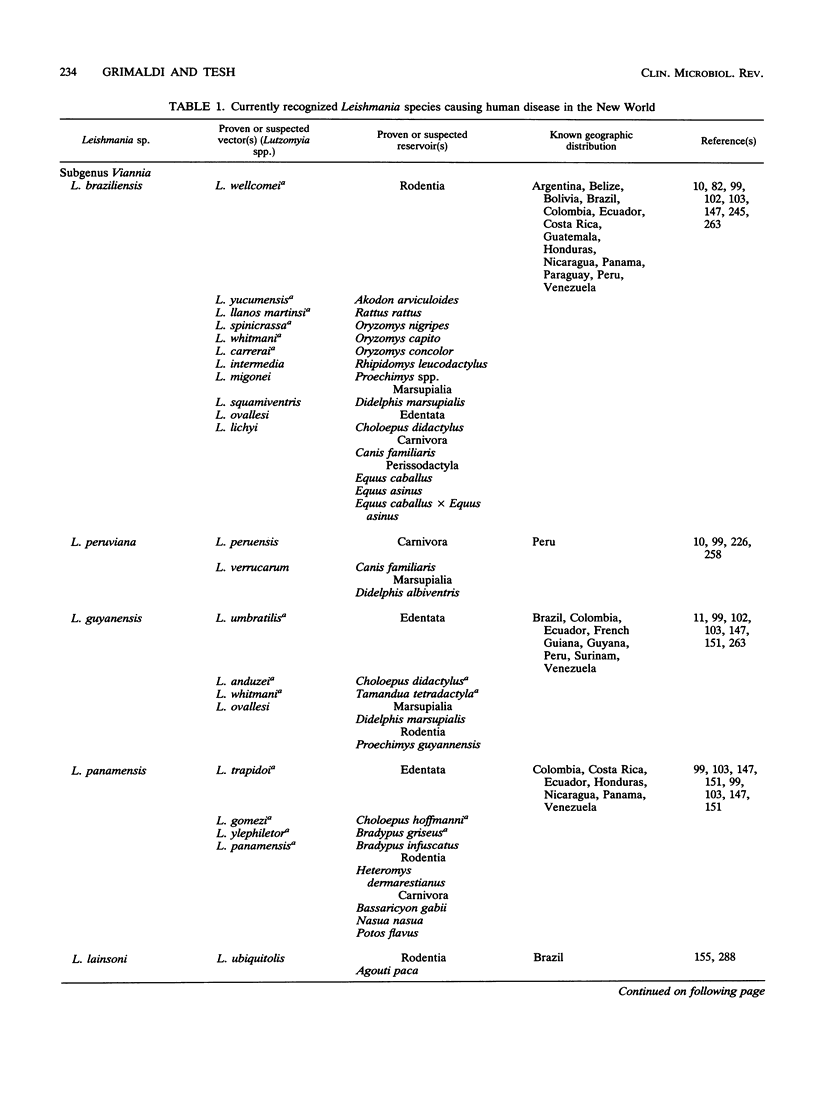
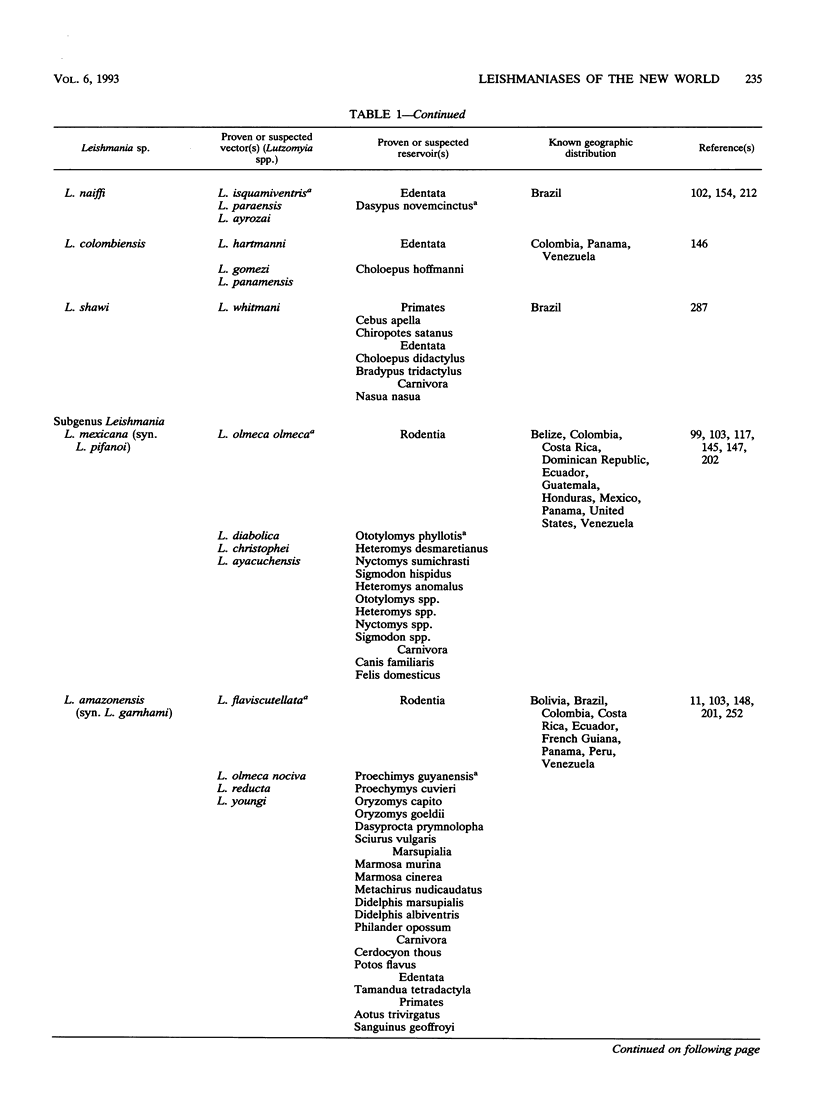
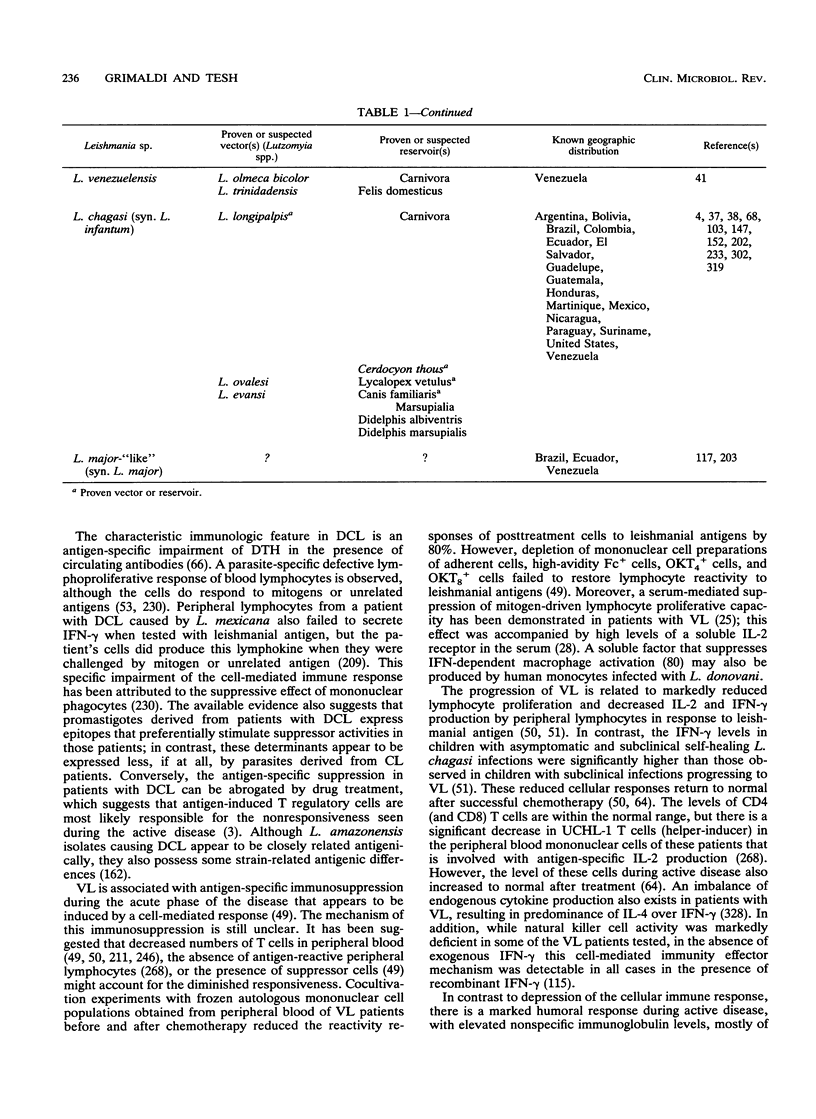
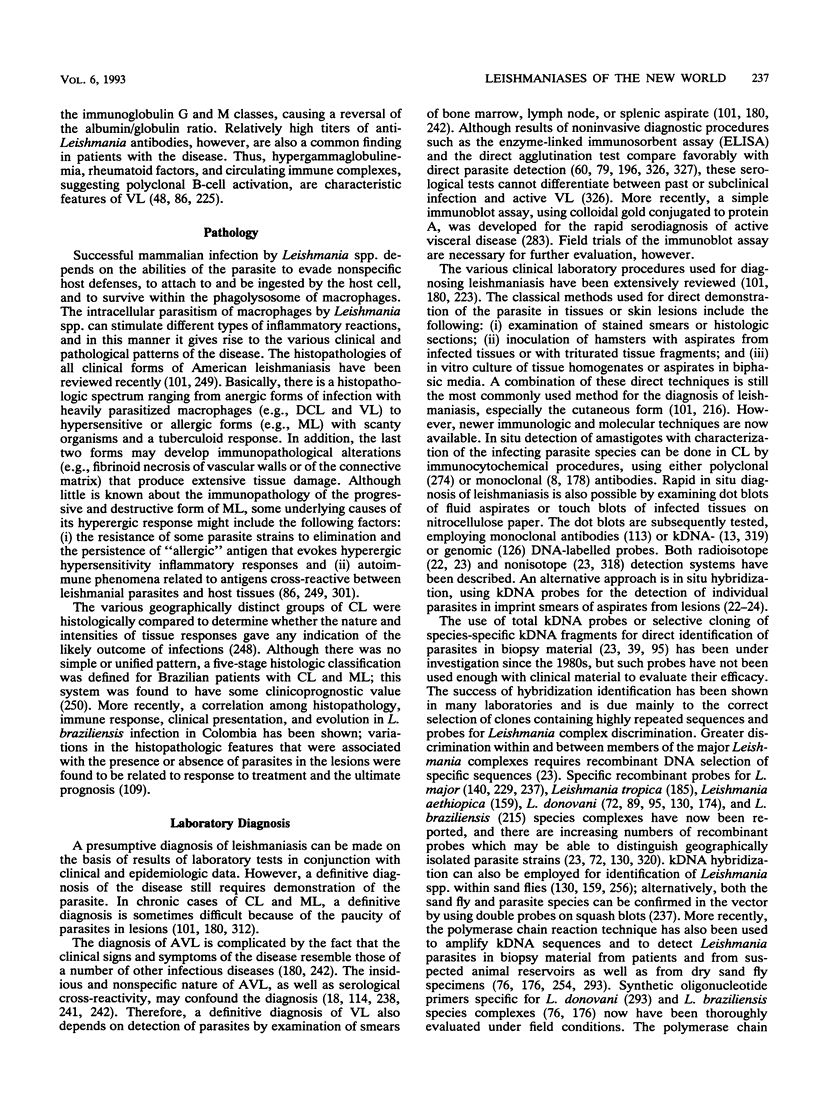

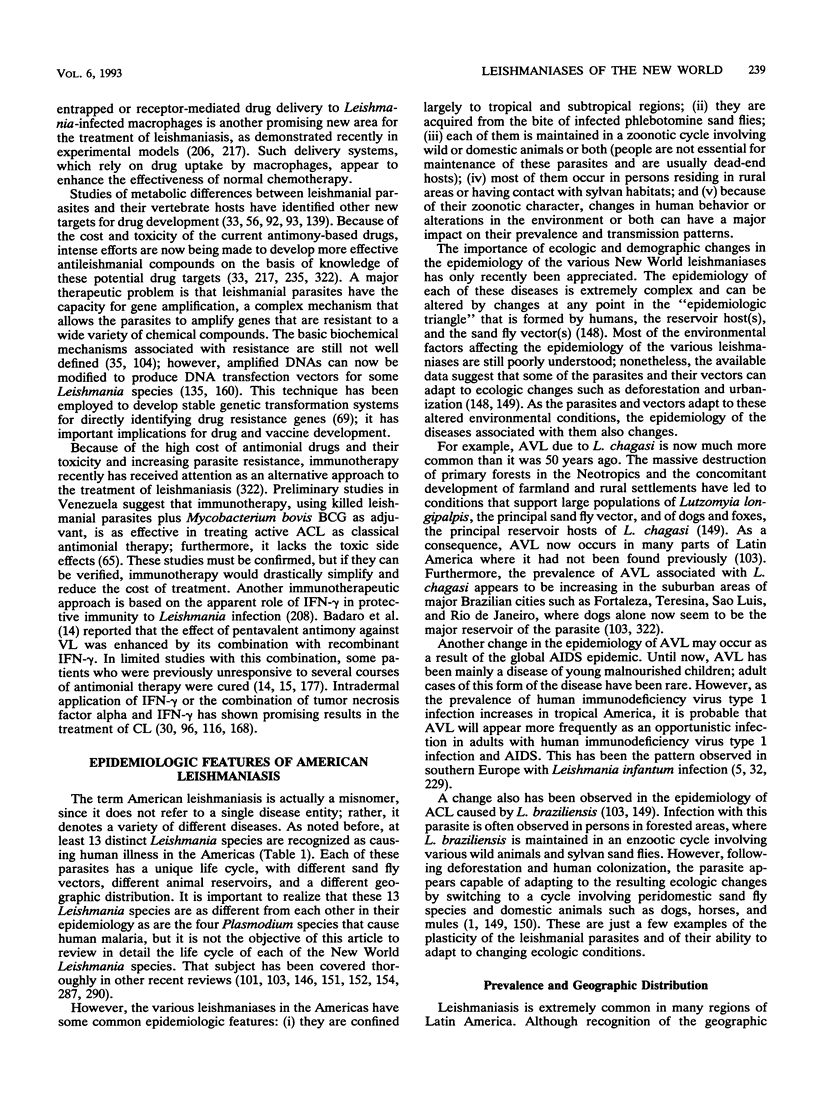

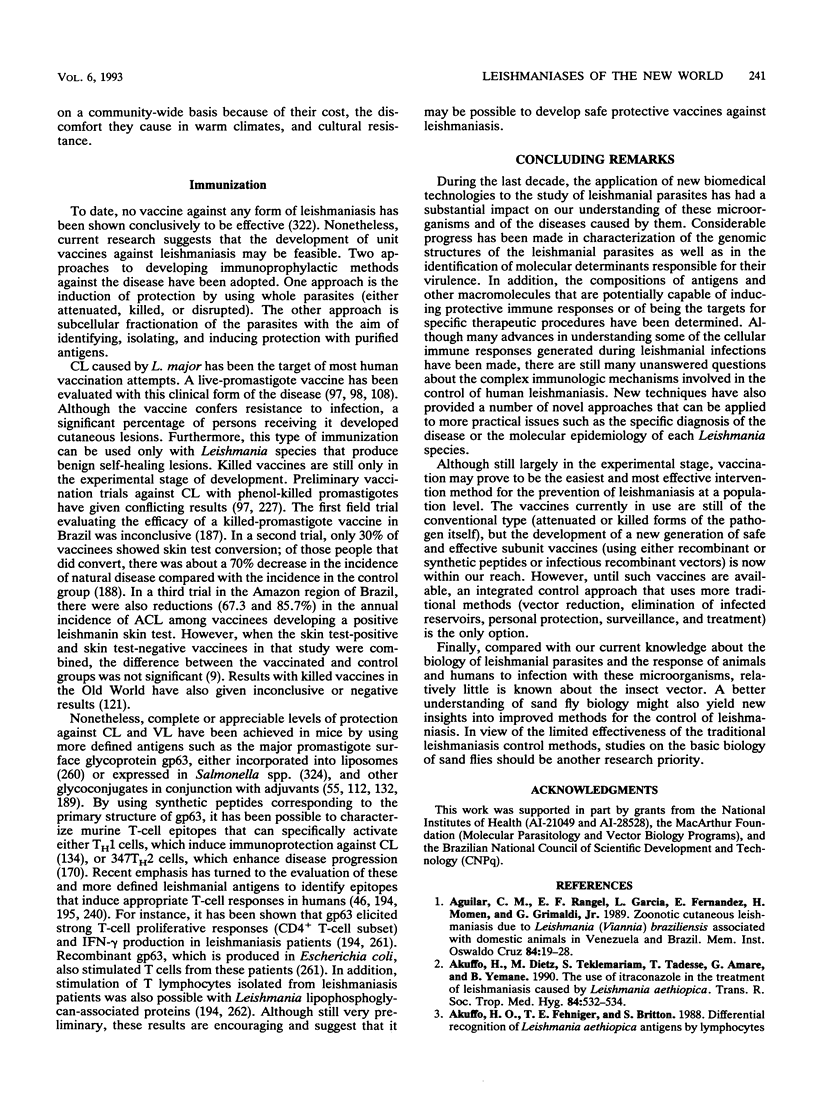
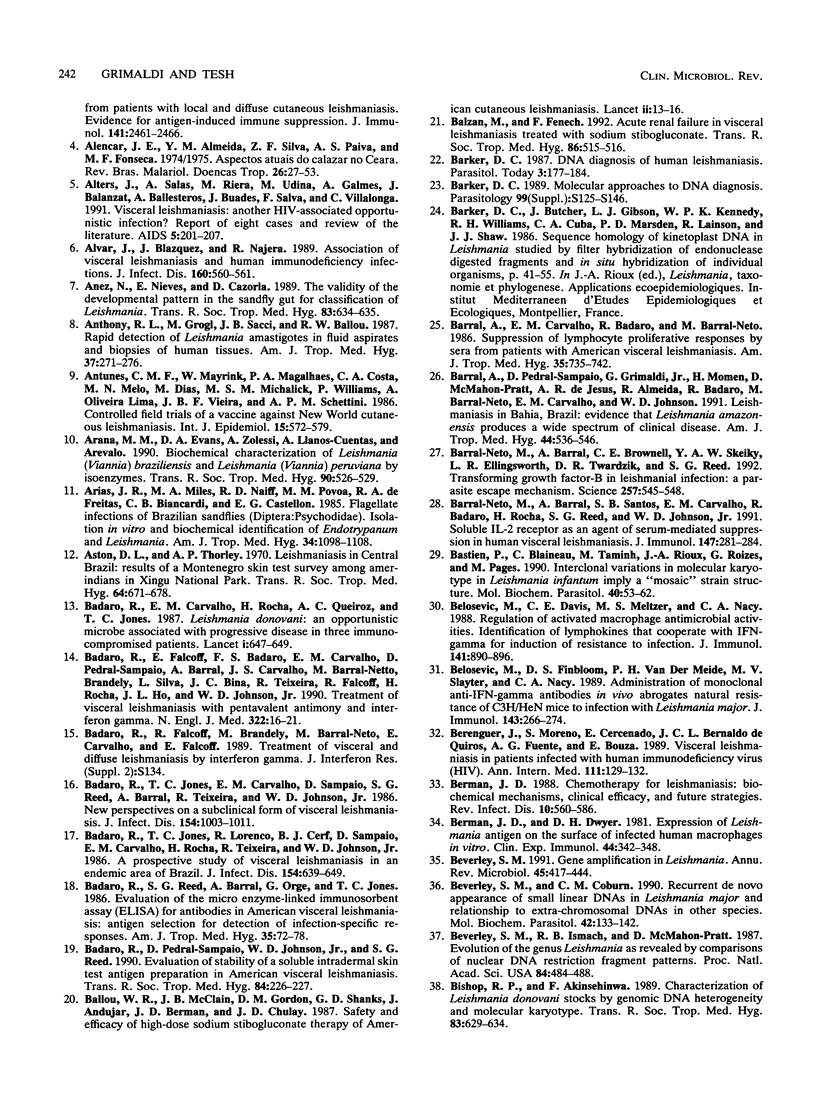
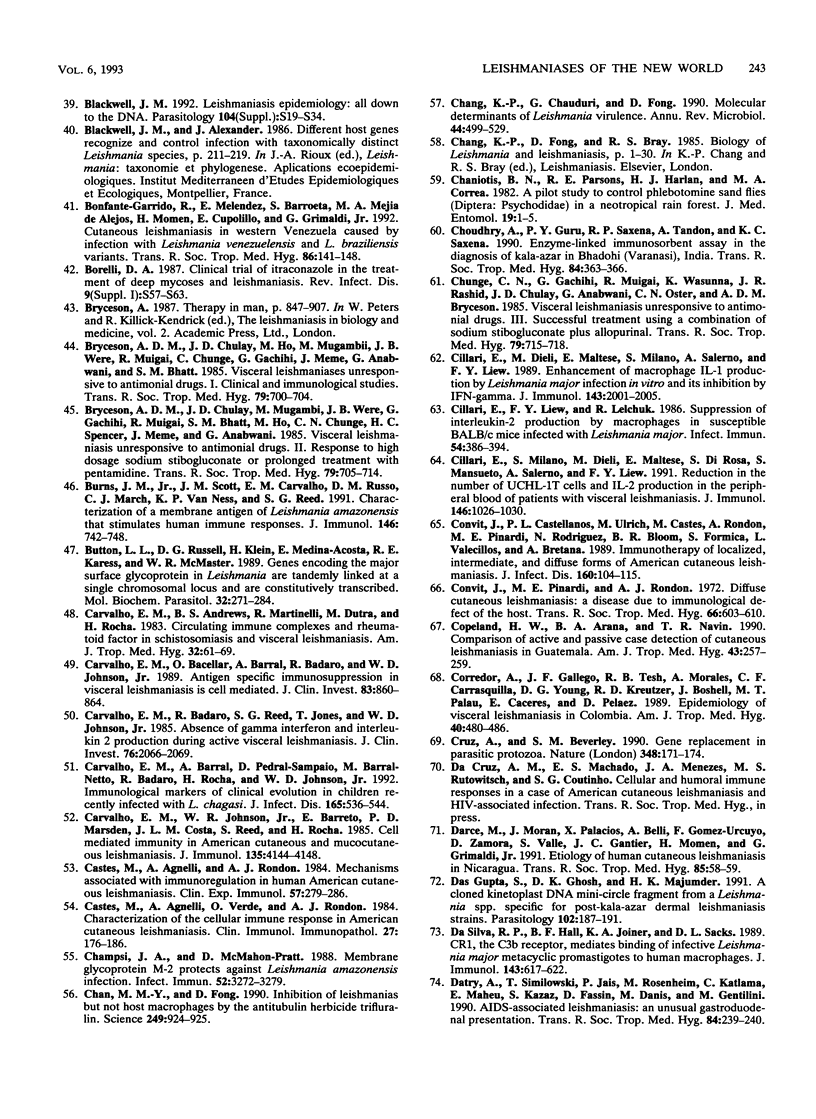
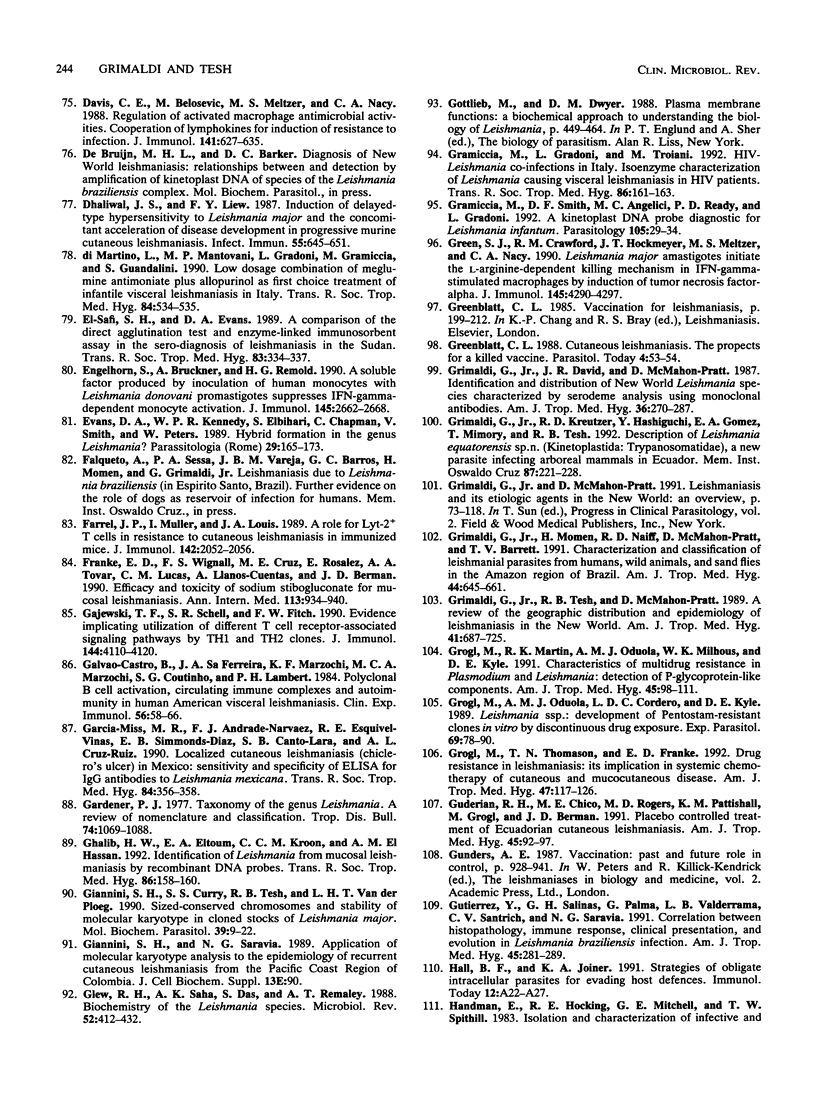

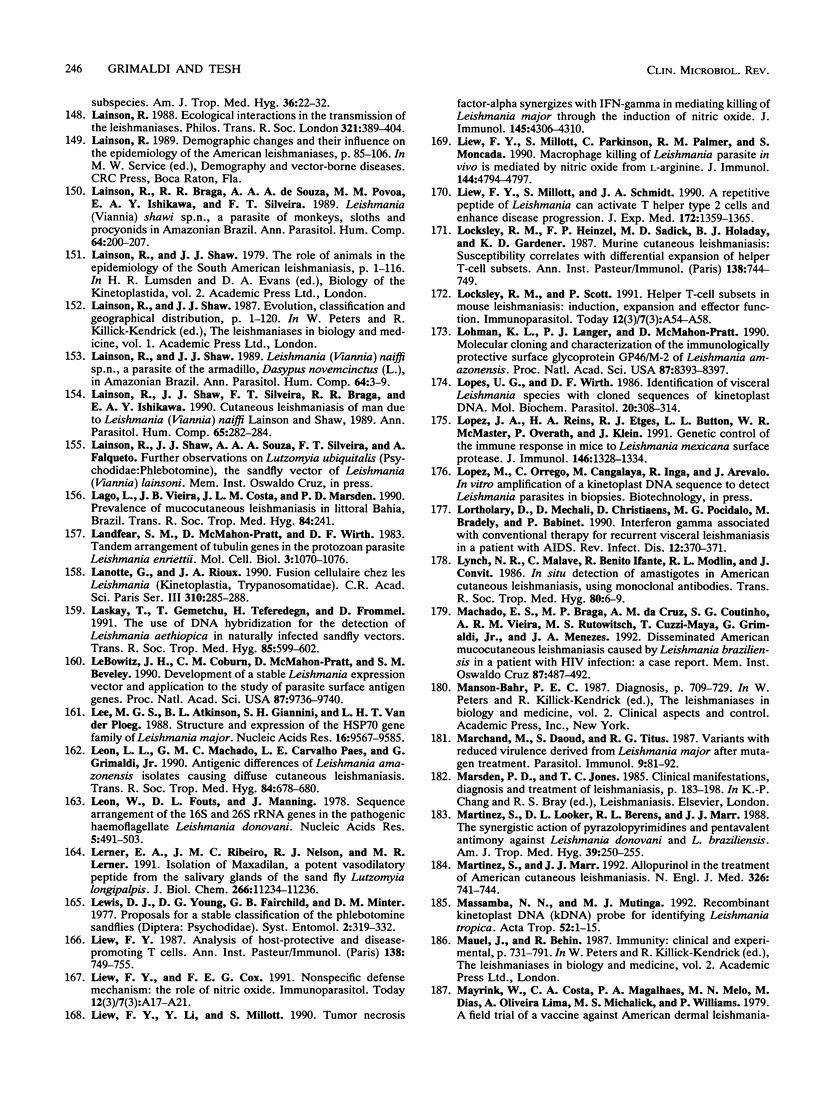
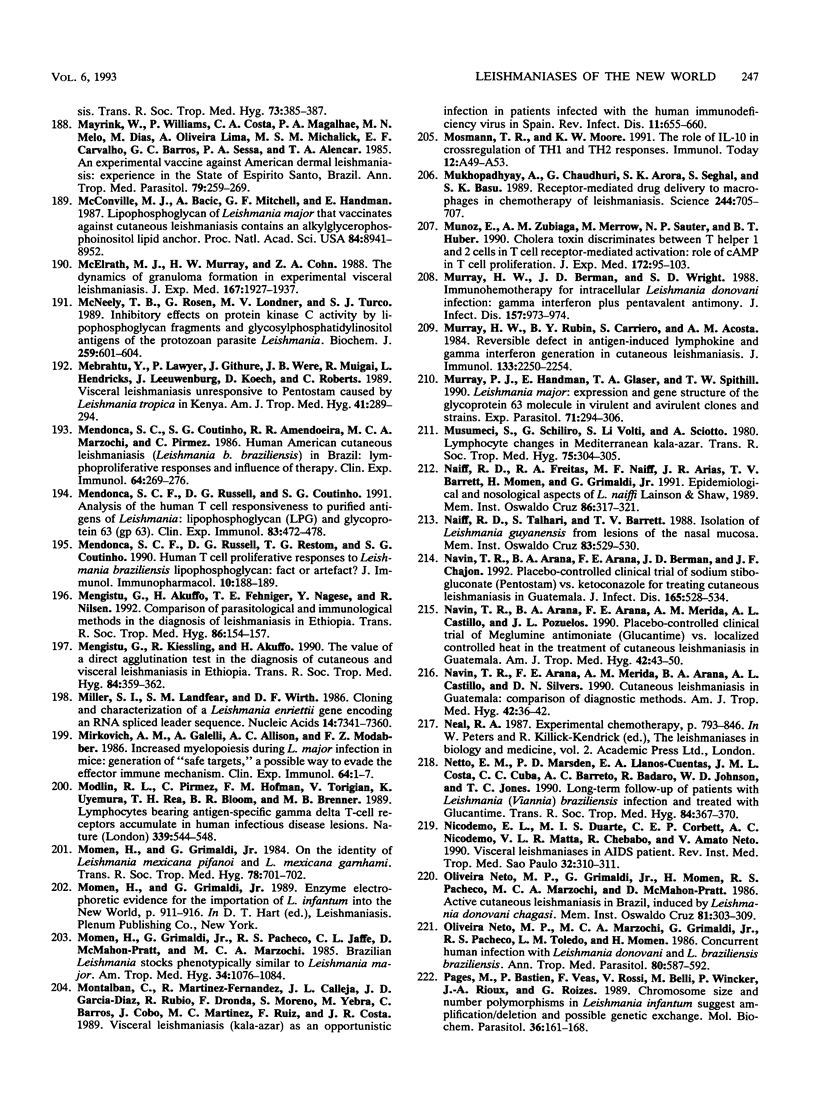
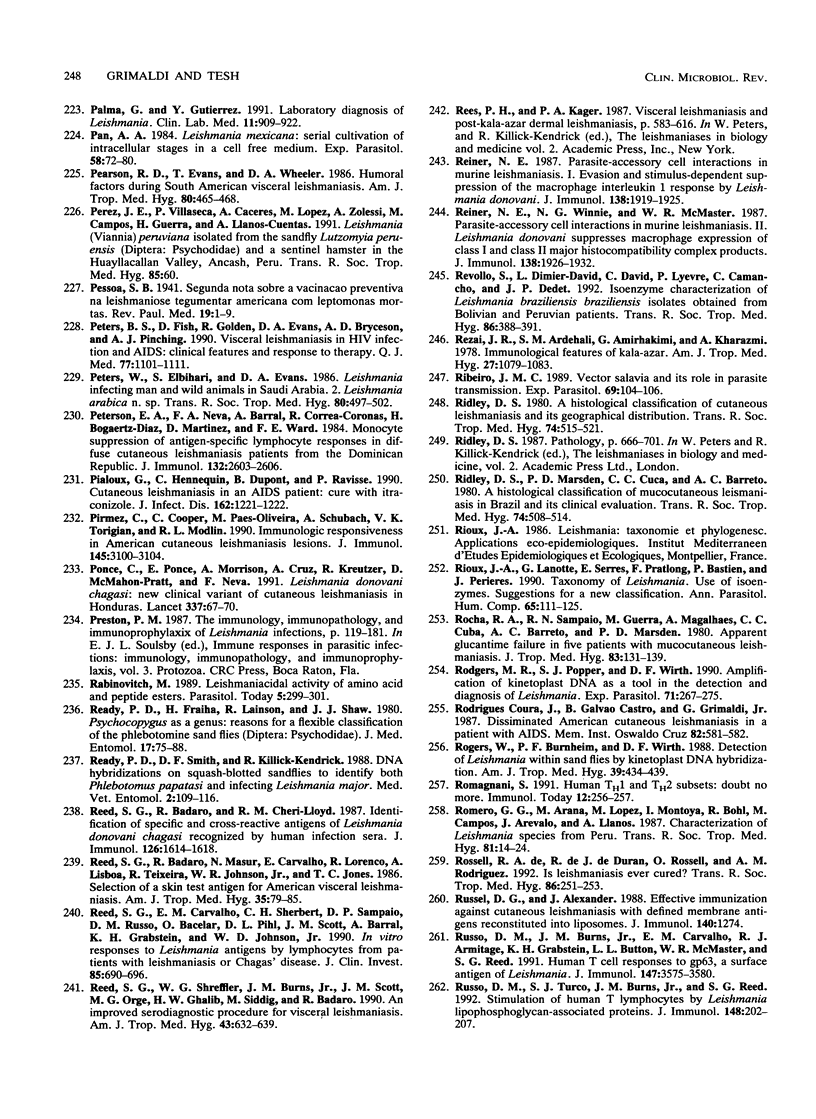
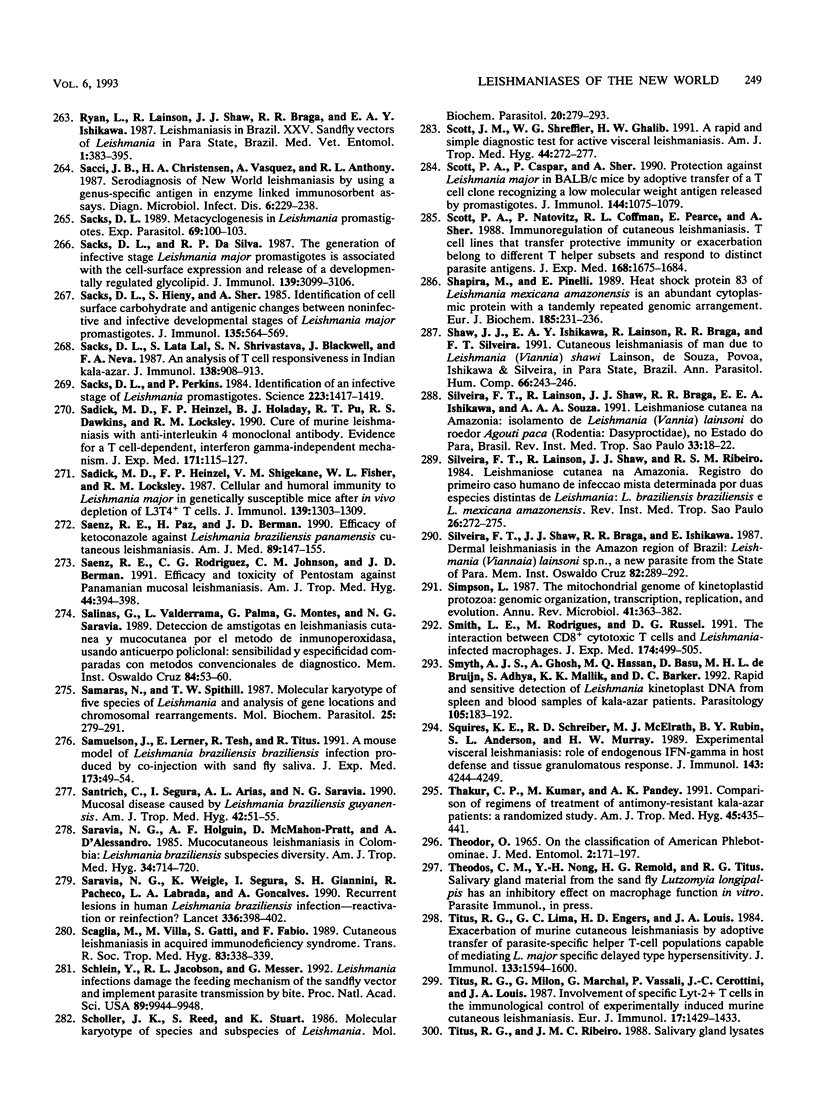
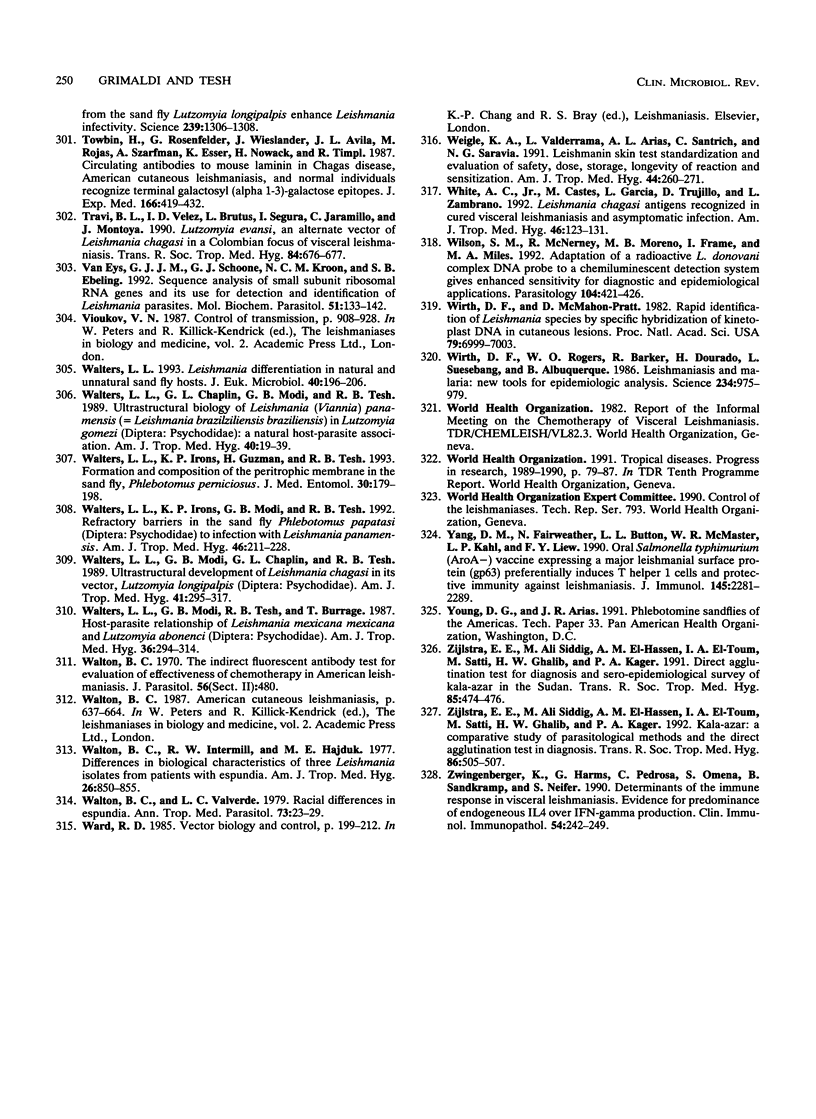
Selected References
These references are in PubMed. This may not be the complete list of references from this article.
- Aguilar C. M., Rangel E. F., Garcia L., Fernandez E., Momen H., Grimaldi Filho G., De Vargas Z. Zoonotic cutaneous leishmaniasis due to Leishmania (Viannia) braziliensis associated with domestic animals in Venezuela and Brazil. Mem Inst Oswaldo Cruz. 1989 Jan-Mar;84(1):19–28. doi: 10.1590/s0074-02761989000100005. [DOI] [PubMed] [Google Scholar]
- Akuffo H., Dietz M., Teklemariam S., Tadesse T., Amare G., Berhan T. Y. The use of itraconazole in the treatment of leishmaniasis caused by Leishmania aethiopica. Trans R Soc Trop Med Hyg. 1990 Jul-Aug;84(4):532–534. doi: 10.1016/0035-9203(90)90028-d. [DOI] [PubMed] [Google Scholar]
- Alencar J. E., Almeida Y. M., e Silva Z. F., Paiva A. S., da Fonseca M. F. Aspectos atuais do Calazar no Ceará. Rev Bras Malariol Doencas Trop. 1974 1975;26-27:27–53. [PubMed] [Google Scholar]
- Altés J., Salas A., Riera M., Udina M., Galmés A., Balanzat J., Ballesteros A., Buades J., Salvá F., Villalonga C. Visceral leishmaniasis: another HIV-associated opportunistic infection? Report of eight cases and review of the literature. AIDS. 1991 Feb;5(2):201–207. [PubMed] [Google Scholar]
- Alvar J., Blazquez J., Najera R. Association of visceral leishmaniasis and human immunodeficiency virus infections. J Infect Dis. 1989 Sep;160(3):560–561. doi: 10.1093/infdis/160.3.560. [DOI] [PubMed] [Google Scholar]
- Anthony R. L., Grogl M., Sacci J. B., Ballou R. W. Rapid detection of Leishmania amastigotes in fluid aspirates and biopsies of human tissues. Am J Trop Med Hyg. 1987 Sep;37(2):271–276. doi: 10.4269/ajtmh.1987.37.271. [DOI] [PubMed] [Google Scholar]
- Antunes C. M., Mayrink W., Magalhaes P. A., Costa C. A., Melo M. N., Dias M., Michalick M. S., Williams P., Lima A. O., Vieira J. B. Controlled field trials of a vaccine against New World cutaneous leishmaniasis. Int J Epidemiol. 1986 Dec;15(4):572–580. doi: 10.1093/ije/15.4.572. [DOI] [PubMed] [Google Scholar]
- Arana M., Evans D. A., Zolessi A., Cuentas A. L., Arevalo J. Biochemical characterization of Leishmania (Viannia) braziliensis and Leishmania (Viannia) peruviana by isoenzyme electrophoresis. Trans R Soc Trop Med Hyg. 1990 Jul-Aug;84(4):526–529. doi: 10.1016/0035-9203(90)90025-a. [DOI] [PubMed] [Google Scholar]
- Arias J. R., Miles M. A., Naiff R. D., Povoa M. M., de Freitas R. A., Biancardi C. B., Castellon E. G. Flagellate infections of Brazilian sand flies (Diptera: Psychodidae): isolation in vitro and biochemical identification of Endotrypanum and Leishmania. Am J Trop Med Hyg. 1985 Nov;34(6):1098–1108. doi: 10.4269/ajtmh.1985.34.1098. [DOI] [PubMed] [Google Scholar]
- Aston D. L., Thorley A. P. Leishmaniasis in Central Brazil: results of a Montenegro skin test survey among Amerindians in the Xingu National Park. Trans R Soc Trop Med Hyg. 1970;64(5):671–678. doi: 10.1016/0035-9203(70)90004-0. [DOI] [PubMed] [Google Scholar]
- Añez N., Nieves E., Cazorla D. The validity of the developmental pattern in the sandfly gut for classification of Leishmania. Trans R Soc Trop Med Hyg. 1989 Sep-Oct;83(5):634–635. doi: 10.1016/0035-9203(89)90378-7. [DOI] [PubMed] [Google Scholar]
- Badaro R., Falcoff E., Badaro F. S., Carvalho E. M., Pedral-Sampaio D., Barral A., Carvalho J. S., Barral-Netto M., Brandely M., Silva L. Treatment of visceral leishmaniasis with pentavalent antimony and interferon gamma. N Engl J Med. 1990 Jan 4;322(1):16–21. doi: 10.1056/NEJM199001043220104. [DOI] [PubMed] [Google Scholar]
- Badaro R., Jones T. C., Carvalho E. M., Sampaio D., Reed S. G., Barral A., Teixeira R., Johnson W. D., Jr New perspectives on a subclinical form of visceral leishmaniasis. J Infect Dis. 1986 Dec;154(6):1003–1011. doi: 10.1093/infdis/154.6.1003. [DOI] [PubMed] [Google Scholar]
- Badaró R., Jones T. C., Lorenço R., Cerf B. J., Sampaio D., Carvalho E. M., Rocha H., Teixeira R., Johnson W. D., Jr A prospective study of visceral leishmaniasis in an endemic area of Brazil. J Infect Dis. 1986 Oct;154(4):639–649. doi: 10.1093/infdis/154.4.639. [DOI] [PubMed] [Google Scholar]
- Badaró R., Pedral-Sampaio D., Johnson W. D., Jr, Reed S. G. Evaluation of the stability of a soluble intradermal skin test antigen preparation in American visceral leishmaniasis. Trans R Soc Trop Med Hyg. 1990 Mar-Apr;84(2):226–227. doi: 10.1016/0035-9203(90)90264-f. [DOI] [PubMed] [Google Scholar]
- Badaró R., Reed S. G., Barral A., Orge G., Jones T. C. Evaluation of the micro enzyme-linked immunosorbent assay (ELISA) for antibodies in American visceral leishmaniasis: antigen selection for detection of infection-specific responses. Am J Trop Med Hyg. 1986 Jan;35(1):72–78. doi: 10.4269/ajtmh.1986.35.72. [DOI] [PubMed] [Google Scholar]
- Ballou W. R., McClain J. B., Gordon D. M., Shanks G. D., Andujar J., Berman J. D., Chulay J. D. Safety and efficacy of high-dose sodium stibogluconate therapy of American cutaneous leishmaniasis. Lancet. 1987 Jul 4;2(8549):13–16. doi: 10.1016/s0140-6736(87)93053-4. [DOI] [PubMed] [Google Scholar]
- Balzan M., Fenech F. Acute renal failure in visceral leishmaniasis treated with sodium stibogluconate. Trans R Soc Trop Med Hyg. 1992 Sep-Oct;86(5):515–516. doi: 10.1016/0035-9203(92)90091-p. [DOI] [PubMed] [Google Scholar]
- Barker D. C. DNA diagnosis of human leishmaniasis. Parasitol Today. 1987 Jun;3(6):177–184. doi: 10.1016/0169-4758(87)90174-8. [DOI] [PubMed] [Google Scholar]
- Barker D. C. Molecular approaches to DNA diagnosis. Parasitology. 1989;99 (Suppl):S125–S146. doi: 10.1017/s0031182000083463. [DOI] [PubMed] [Google Scholar]
- Barral-Netto M., Barral A., Brownell C. E., Skeiky Y. A., Ellingsworth L. R., Twardzik D. R., Reed S. G. Transforming growth factor-beta in leishmanial infection: a parasite escape mechanism. Science. 1992 Jul 24;257(5069):545–548. doi: 10.1126/science.1636092. [DOI] [PubMed] [Google Scholar]
- Barral-Netto M., Barral A., Santos S. B., Carvalho E. M., Badaro R., Rocha H., Reed S. G., Johnson W. D., Jr Soluble IL-2 receptor as an agent of serum-mediated suppression in human visceral leishmaniasis. J Immunol. 1991 Jul 1;147(1):281–284. [PubMed] [Google Scholar]
- Barral A., Carvalho E. M., Badaró R., Barral-Netto M. Suppression of lymphocyte proliferative responses by sera from patients with American visceral leishmaniasis. Am J Trop Med Hyg. 1986 Jul;35(4):735–742. doi: 10.4269/ajtmh.1986.35.735. [DOI] [PubMed] [Google Scholar]
- Barral A., Pedral-Sampaio D., Grimaldi Júnior G., Momen H., McMahon-Pratt D., Ribeiro de Jesus A., Almeida R., Badaro R., Barral-Netto M., Carvalho E. M. Leishmaniasis in Bahia, Brazil: evidence that Leishmania amazonensis produces a wide spectrum of clinical disease. Am J Trop Med Hyg. 1991 May;44(5):536–546. doi: 10.4269/ajtmh.1991.44.536. [DOI] [PubMed] [Google Scholar]
- Bastien P., Blaineau C., Taminh M., Rioux J. A., Roizès G., Pagès M. Interclonal variations in molecular karyotype in Leishmania infantum imply a 'mosaic' strain structure. Mol Biochem Parasitol. 1990 Apr;40(1):53–61. doi: 10.1016/0166-6851(90)90079-2. [DOI] [PubMed] [Google Scholar]
- Belosevic M., Davis C. E., Meltzer M. S., Nacy C. A. Regulation of activated macrophage antimicrobial activities. Identification of lymphokines that cooperate with IFN-gamma for induction of resistance to infection. J Immunol. 1988 Aug 1;141(3):890–896. [PubMed] [Google Scholar]
- Belosevic M., Finbloom D. S., Van Der Meide P. H., Slayter M. V., Nacy C. A. Administration of monoclonal anti-IFN-gamma antibodies in vivo abrogates natural resistance of C3H/HeN mice to infection with Leishmania major. J Immunol. 1989 Jul 1;143(1):266–274. [PubMed] [Google Scholar]
- Berenguer J., Moreno S., Cercenado E., Bernaldo de Quirós J. C., García de la Fuente A., Bouza E. Visceral leishmaniasis in patients infected with human immunodeficiency virus (HIV). Ann Intern Med. 1989 Jul 15;111(2):129–132. doi: 10.7326/0003-4819-111-2-129. [DOI] [PubMed] [Google Scholar]
- Berman J. D. Chemotherapy for leishmaniasis: biochemical mechanisms, clinical efficacy, and future strategies. Rev Infect Dis. 1988 May-Jun;10(3):560–586. doi: 10.1093/clinids/10.3.560. [DOI] [PubMed] [Google Scholar]
- Berman J. D., Dwyer D. M. Expression of Leishmania antigen on the surface membrane of infected human macrophages in vitro. Clin Exp Immunol. 1981 May;44(2):342–348. [PMC free article] [PubMed] [Google Scholar]
- Beverley S. M., Coburn C. M. Recurrent de novo appearance of small linear DNAs in Leishmania major and relationship to extra-chromosomal DNAs in other species. Mol Biochem Parasitol. 1990 Aug;42(1):133–141. doi: 10.1016/0166-6851(90)90121-2. [DOI] [PubMed] [Google Scholar]
- Beverley S. M. Gene amplification in Leishmania. Annu Rev Microbiol. 1991;45:417–444. doi: 10.1146/annurev.mi.45.100191.002221. [DOI] [PubMed] [Google Scholar]
- Beverley S. M., Ismach R. B., Pratt D. M. Evolution of the genus Leishmania as revealed by comparisons of nuclear DNA restriction fragment patterns. Proc Natl Acad Sci U S A. 1987 Jan;84(2):484–488. doi: 10.1073/pnas.84.2.484. [DOI] [PMC free article] [PubMed] [Google Scholar]
- Bishop R. P., Akinsehinwa F. Characterization of Leishmania donovani stocks by genomic DNA heterogeneity and molecular karyotype. Trans R Soc Trop Med Hyg. 1989 Sep-Oct;83(5):629–634. doi: 10.1016/0035-9203(89)90377-5. [DOI] [PubMed] [Google Scholar]
- Blackwell J. M. Leishmaniasis epidemiology: all down to the DNA. Parasitology. 1992;104 (Suppl):S19–S34. doi: 10.1017/s0031182000075223. [DOI] [PubMed] [Google Scholar]
- Bonfante-Garrido R., Meléndez E., Barroeta S., de Alejos M. A., Momen H., Cupolillo E., McMahon-Pratt D., Grimaldi G., Jr Cutaneous leishmaniasis in western Venezuela caused by infection with Leishmania venezuelensis and L. braziliensis variants. Trans R Soc Trop Med Hyg. 1992 Mar-Apr;86(2):141–148. doi: 10.1016/0035-9203(92)90544-m. [DOI] [PubMed] [Google Scholar]
- Borelli D. A clinical trial of itraconazole in the treatment of deep mycoses and leishmaniasis. Rev Infect Dis. 1987 Jan-Feb;9 (Suppl 1):S57–S63. doi: 10.1093/clinids/9.supplement_1.s57. [DOI] [PubMed] [Google Scholar]
- Bryceson A. D., Chulay J. D., Ho M., Mugambii M., Were J. B., Muigai R., Chunge C., Gachihi G., Meme J., Anabwani G. Visceral leishmaniasis unresponsive to antimonial drugs. I. Clinical and immunological studies. Trans R Soc Trop Med Hyg. 1985;79(5):700–704. doi: 10.1016/0035-9203(85)90197-x. [DOI] [PubMed] [Google Scholar]
- Bryceson A. D., Chulay J. D., Mugambi M., Were J. B., Gachihi G., Chunge C. N., Muigai R., Bhatt S. M., Ho M., Spencer H. C. Visceral leishmaniasis unresponsive to antimonial drugs. II. Response to high dosage sodium stibogluconate or prolonged treatment with pentamidine. Trans R Soc Trop Med Hyg. 1985;79(5):705–714. doi: 10.1016/0035-9203(85)90199-3. [DOI] [PubMed] [Google Scholar]
- Burns J. M., Jr, Scott J. M., Carvalho E. M., Russo D. M., March C. J., Van Ness K. P., Reed S. G. Characterization of a membrane antigen of Leishmania amazonensis that stimulates human immune responses. J Immunol. 1991 Jan 15;146(2):742–748. [PubMed] [Google Scholar]
- Button L. L., Russell D. G., Klein H. L., Medina-Acosta E., Karess R. E., McMaster W. R. Genes encoding the major surface glycoprotein in Leishmania are tandemly linked at a single chromosomal locus and are constitutively transcribed. Mol Biochem Parasitol. 1989 Jan 15;32(2-3):271–283. doi: 10.1016/0166-6851(89)90076-5. [DOI] [PubMed] [Google Scholar]
- Carvalho E. M., Andrews B. S., Martinelli R., Dutra M., Rocha H. Circulating immune complexes and rheumatoid factor in schistosomiasis and visceral leishmaniasis. Am J Trop Med Hyg. 1983 Jan;32(1):61–68. doi: 10.4269/ajtmh.1983.32.61. [DOI] [PubMed] [Google Scholar]
- Carvalho E. M., Bacellar O., Barral A., Badaro R., Johnson W. D., Jr Antigen-specific immunosuppression in visceral leishmaniasis is cell mediated. J Clin Invest. 1989 Mar;83(3):860–864. doi: 10.1172/JCI113969. [DOI] [PMC free article] [PubMed] [Google Scholar]
- Carvalho E. M., Badaró R., Reed S. G., Jones T. C., Johnson W. D., Jr Absence of gamma interferon and interleukin 2 production during active visceral leishmaniasis. J Clin Invest. 1985 Dec;76(6):2066–2069. doi: 10.1172/JCI112209. [DOI] [PMC free article] [PubMed] [Google Scholar]
- Carvalho E. M., Johnson W. D., Barreto E., Marsden P. D., Costa J. L., Reed S., Rocha H. Cell mediated immunity in American cutaneous and mucosal leishmaniasis. J Immunol. 1985 Dec;135(6):4144–4148. [PubMed] [Google Scholar]
- Castes M., Agnelli A., Verde O., Rondón A. J. Characterization of the cellular immune response in American cutaneous leishmaniasis. Clin Immunol Immunopathol. 1983 May;27(2):176–186. doi: 10.1016/0090-1229(83)90068-5. [DOI] [PubMed] [Google Scholar]
- Castés M., Agnelli A., Rondón A. J. Mechanisms associated with immunoregulation in human American cutaneous leishmaniasis. Clin Exp Immunol. 1984 Aug;57(2):279–286. [PMC free article] [PubMed] [Google Scholar]
- Champsi J., McMahon-Pratt D. Membrane glycoprotein M-2 protects against Leishmania amazonensis infection. Infect Immun. 1988 Dec;56(12):3272–3279. doi: 10.1128/iai.56.12.3272-3279.1988. [DOI] [PMC free article] [PubMed] [Google Scholar]
- Chan M. M., Fong D. Inhibition of leishmanias but not host macrophages by the antitubulin herbicide trifluralin. Science. 1990 Aug 24;249(4971):924–926. doi: 10.1126/science.2392684. [DOI] [PubMed] [Google Scholar]
- Chang K. P., Chaudhuri G., Fong D. Molecular determinants of Leishmania virulence. Annu Rev Microbiol. 1990;44:499–529. doi: 10.1146/annurev.mi.44.100190.002435. [DOI] [PubMed] [Google Scholar]
- Chaniotis B. N., Parsons R. E., Harlan H. J., Correa M. A. A pilot study to control phlebotomine sand flies (Diptera: Psychodidae) in a neotropical rain forest. J Med Entomol. 1982 Jan 28;19(1):1–5. doi: 10.1093/jmedent/19.1.1. [DOI] [PubMed] [Google Scholar]
- Choudhry A., Guru P. Y., Saxena R. P., Tandon A., Saxena K. C. Enzyme-linked immunosorbent assay in the diagnosis of kala-azar in Bhadohi (Varanasi), India. Trans R Soc Trop Med Hyg. 1990 May-Jun;84(3):363–366. doi: 10.1016/0035-9203(90)90319-a. [DOI] [PubMed] [Google Scholar]
- Chunge C. N., Gachihi G., Muigai R., Wasunna K., Rashid J. R., Chulay J. D., Anabwani G., Oster C. N., Bryceson A. D. Visceral leishmaniasis unresponsive to antimonial drugs. III. Successful treatment using a combination of sodium stibogluconate plus allopurinol. Trans R Soc Trop Med Hyg. 1985;79(5):715–718. doi: 10.1016/0035-9203(85)90200-7. [DOI] [PubMed] [Google Scholar]
- Cillari E., Dieli M., Maltese E., Milano S., Salerno A., Liew F. Y. Enhancement of macrophage IL-1 production by Leishmania major infection in vitro and its inhibition by IFN-gamma. J Immunol. 1989 Sep 15;143(6):2001–2005. [PubMed] [Google Scholar]
- Cillari E., Liew F. Y., Lelchuk R. Suppression of interleukin-2 production by macrophages in genetically susceptible mice infected with Leishmania major. Infect Immun. 1986 Nov;54(2):386–394. doi: 10.1128/iai.54.2.386-394.1986. [DOI] [PMC free article] [PubMed] [Google Scholar]
- Cillari E., Milano S., Dieli M., Maltese E., Di Rosa S., Mansueto S., Salerno A., Liew F. Y. Reduction in the number of UCHL-1+ cells and IL-2 production in the peripheral blood of patients with visceral leishmaniasis. J Immunol. 1991 Feb 1;146(3):1026–1030. [PubMed] [Google Scholar]
- Convit J., Castellanos P. L., Ulrich M., Castés M., Rondón A., Pinardi M. E., Rodríquez N., Bloom B. R., Formica S., Valecillos L. Immunotherapy of localized, intermediate, and diffuse forms of American cutaneous leishmaniasis. J Infect Dis. 1989 Jul;160(1):104–115. doi: 10.1093/infdis/160.1.104. [DOI] [PubMed] [Google Scholar]
- Convit J., Pinardi M. E., Rondón A. J. Diffuse cutaneous leishmaniasis: a disease due to an immunological defect of the host. Trans R Soc Trop Med Hyg. 1972;66(4):603–610. doi: 10.1016/0035-9203(72)90306-9. [DOI] [PubMed] [Google Scholar]
- Copeland H. W., Arana B. A., Navin T. R. Comparison of active and passive case detection of cutaneous leishmaniasis in Guatemala. Am J Trop Med Hyg. 1990 Sep;43(3):257–259. doi: 10.4269/ajtmh.1990.43.257. [DOI] [PubMed] [Google Scholar]
- Corredor A., Gallego J. F., Tesh R. B., Morales A., De Carrasquilla C. F., Young D. G., Kreutzer R. D., Boshell J., Palau M. T., Caceres E. Epidemiology of visceral leishmaniasis in Colombia. Am J Trop Med Hyg. 1989 May;40(5):480–486. doi: 10.4269/ajtmh.1989.40.480. [DOI] [PubMed] [Google Scholar]
- Coura J. R., Galvão-Castro B., Grimaldi Júnior G. Disseminated American cutaneous leishmaniasis in a patient with AIDS. Mem Inst Oswaldo Cruz. 1987 Oct-Dec;82(4):581–582. doi: 10.1590/s0074-02761987000400019. [DOI] [PubMed] [Google Scholar]
- Cruz A., Beverley S. M. Gene replacement in parasitic protozoa. Nature. 1990 Nov 8;348(6297):171–173. doi: 10.1038/348171a0. [DOI] [PubMed] [Google Scholar]
- Da Silva R. P., Hall B. F., Joiner K. A., Sacks D. L. CR1, the C3b receptor, mediates binding of infective Leishmania major metacyclic promastigotes to human macrophages. J Immunol. 1989 Jul 15;143(2):617–622. [PubMed] [Google Scholar]
- Darce M., Moran J., Palacios X., Belli A., Gomez-Urcuyo F., Zamora D., Valle S., Gantier J. C., Momen H., Grimaldi Júnior G. Etiology of human cutaneous leishmaniasis in Nicaragua. Trans R Soc Trop Med Hyg. 1991 Jan-Feb;85(1):58–59. doi: 10.1016/0035-9203(91)90157-t. [DOI] [PubMed] [Google Scholar]
- Das Gupta S., Ghosh D. K., Majumder H. K. A cloned kinetoplast DNA mini-circle fragment from a Leishmania spp. specific for post-kala-azar dermal leishmaniasis strains. Parasitology. 1991 Apr;102(Pt 2):187–191. doi: 10.1017/s0031182000062478. [DOI] [PubMed] [Google Scholar]
- Datry A., Similowski T., Jais P., Rosenheim M., Katlama C., Maheu E., Kazaz S., Fassin D., Danis M., Gentilini M. AIDS-associated leishmaniasis: an unusual gastro-duodenal presentation. Trans R Soc Trop Med Hyg. 1990 Mar-Apr;84(2):239–240. doi: 10.1016/0035-9203(90)90269-k. [DOI] [PubMed] [Google Scholar]
- Davis C. E., Belosevic M., Meltzer M. S., Nacy C. A. Regulation of activated macrophage antimicrobial activities. Cooperation of lymphokines for induction of resistance to infection. J Immunol. 1988 Jul 15;141(2):627–635. [PubMed] [Google Scholar]
- Dhaliwal J. S., Liew F. Y. Induction of delayed-type hypersensitivity to Leishmania major and the concomitant acceleration of disease development in progressive murine cutaneous leishmaniasis. Infect Immun. 1987 Mar;55(3):645–651. doi: 10.1128/iai.55.3.645-651.1987. [DOI] [PMC free article] [PubMed] [Google Scholar]
- Engelhorn S., Bruckner A., Remold H. G. A soluble factor produced by inoculation of human monocytes with Leishmania donovani promastigotes suppresses IFN-gamma-dependent monocyte activation. J Immunol. 1990 Oct 15;145(8):2662–2668. [PubMed] [Google Scholar]
- Evans D. A., Kennedy W. P., Elbihari S., Chapman C. J., Smith V., Peters W. Hybrid formation within the genus Leishmania? Parassitologia. 1987 May-Dec;29(2-3):165–173. [PubMed] [Google Scholar]
- Farrell J. P., Muller I., Louis J. A. A role for Lyt-2+ T cells in resistance to cutaneous leishmaniasis in immunized mice. J Immunol. 1989 Mar 15;142(6):2052–2056. [PubMed] [Google Scholar]
- Franke E. D., Wignall F. S., Cruz M. E., Rosales E., Tovar A. A., Lucas C. M., Llanos-Cuentas A., Berman J. D. Efficacy and toxicity of sodium stibogluconate for mucosal leishmaniasis. Ann Intern Med. 1990 Dec 15;113(12):934–940. doi: 10.7326/0003-4819-113-12-934. [DOI] [PubMed] [Google Scholar]
- Gajewski T. F., Schell S. R., Fitch F. W. Evidence implicating utilization of different T cell receptor-associated signaling pathways by TH1 and TH2 clones. J Immunol. 1990 Jun 1;144(11):4110–4120. [PubMed] [Google Scholar]
- Galvão-Castro B., Sá Ferreira J. A., Marzochi K. F., Marzochi M. C., Coutinho S. G., Lambert P. H. Polyclonal B cell activation, circulating immune complexes and autoimmunity in human american visceral leishmaniasis. Clin Exp Immunol. 1984 Apr;56(1):58–66. [PMC free article] [PubMed] [Google Scholar]
- Garcia-Miss M. R., Andrade-Narvaez F. J., Esquivel-Viñas R. E., Simmonds-Diaz E. B., Canto-Lara S. B., Cruz-Ruiz A. L. Localized cutaneous leishmaniasis (chiclero's ulcer) in Mexico: sensitivity and specificity of ELISA for IgG antibodies to Leishmania mexicana mexicana. Trans R Soc Trop Med Hyg. 1990 May-Jun;84(3):356–358. doi: 10.1016/0035-9203(90)90316-7. [DOI] [PubMed] [Google Scholar]
- Gardener P. J. Taxonomy of the genus Leishmania: a review of nomenclature and classification. Trop Dis Bull. 1977 Dec;74(12):1069–1088. [PubMed] [Google Scholar]
- Ghalib H. W., Eltoum E. A., Kroon C. C., el Hassan A. M. Identification of Leishmania from mucosal leishmaniasis by recombinant DNA probes. Trans R Soc Trop Med Hyg. 1992 Mar-Apr;86(2):158–160. doi: 10.1016/0035-9203(92)90549-r. [DOI] [PubMed] [Google Scholar]
- Giannini S. H., Curry S. S., Tesh R. B., Van der Ploeg L. H. Size-conserved chromosomes and stability of molecular karyotype in cloned stocks of Leishmania major. Mol Biochem Parasitol. 1990 Feb;39(1):9–21. doi: 10.1016/0166-6851(90)90003-5. [DOI] [PubMed] [Google Scholar]
- Glew R. H., Saha A. K., Das S., Remaley A. T. Biochemistry of the Leishmania species. Microbiol Rev. 1988 Dec;52(4):412–432. doi: 10.1128/mr.52.4.412-432.1988. [DOI] [PMC free article] [PubMed] [Google Scholar]
- Gramiccia M., Gradoni L., Troiani M. HIV-Leishmania co-infections in Italy. Isoenzyme characterization of Leishmania causing visceral leishmaniasis in HIV patients. Trans R Soc Trop Med Hyg. 1992 Mar-Apr;86(2):161–163. doi: 10.1016/0035-9203(92)90551-m. [DOI] [PubMed] [Google Scholar]
- Gramiccia M., Smith D. F., Angelici M. C., Ready P. D., Gradoni L. A kinetoplast DNA probe diagnostic for Leishmania infantum. Parasitology. 1992 Aug;105(Pt 1):29–34. doi: 10.1017/s0031182000073650. [DOI] [PubMed] [Google Scholar]
- Green S. J., Crawford R. M., Hockmeyer J. T., Meltzer M. S., Nacy C. A. Leishmania major amastigotes initiate the L-arginine-dependent killing mechanism in IFN-gamma-stimulated macrophages by induction of tumor necrosis factor-alpha. J Immunol. 1990 Dec 15;145(12):4290–4297. [PubMed] [Google Scholar]
- Greenblatt C. L. Cutaneous leishmaniasis: The prospects for a killed vaccine. Parasitol Today. 1988 Feb;4(2):53–54. doi: 10.1016/0169-4758(88)90067-1. [DOI] [PubMed] [Google Scholar]
- Grimaldi Júnior G., Kreutzer R. D., Hashiguchi Y., Gomez E. A., Mimory T., Tesh R. B. Description of Leishmania equatorensis sp. n (Kinetoplastida: Trypanosomatidae), a new parasite infecting arboreal mammals in Ecuador. Mem Inst Oswaldo Cruz. 1992 Apr-Jun;87(2):221–228. doi: 10.1590/s0074-02761992000200009. [DOI] [PubMed] [Google Scholar]
- Grimaldi G., Jr, David J. R., McMahon-Pratt D. Identification and distribution of New World Leishmania species characterized by serodeme analysis using monoclonal antibodies. Am J Trop Med Hyg. 1987 Mar;36(2):270–287. doi: 10.4269/ajtmh.1987.36.270. [DOI] [PubMed] [Google Scholar]
- Grimaldi G., Jr, McMahan-Pratt D. Leishmaniasis and its etiologic agents in the New World: an overview. Prog Clin Parasitol. 1991;2:73–118. [PubMed] [Google Scholar]
- Grimaldi G., Jr, Momen H., Naiff R. D., McMahon-Pratt D., Barrett T. V. Characterization and classification of leishmanial parasites from humans, wild mammals, and sand flies in the Amazon region of Brazil. Am J Trop Med Hyg. 1991 Jun;44(6):645–661. doi: 10.4269/ajtmh.1991.44.645. [DOI] [PubMed] [Google Scholar]
- Grimaldi G., Jr, Tesh R. B., McMahon-Pratt D. A review of the geographic distribution and epidemiology of leishmaniasis in the New World. Am J Trop Med Hyg. 1989 Dec;41(6):687–725. doi: 10.4269/ajtmh.1989.41.687. [DOI] [PubMed] [Google Scholar]
- Grogl M., Martin R. K., Oduola A. M., Milhous W. K., Kyle D. E. Characteristics of multidrug resistance in Plasmodium and Leishmania: detection of P-glycoprotein-like components. Am J Trop Med Hyg. 1991 Jul;45(1):98–111. doi: 10.4269/ajtmh.1991.45.98. [DOI] [PubMed] [Google Scholar]
- Grogl M., Thomason T. N., Franke E. D. Drug resistance in leishmaniasis: its implication in systemic chemotherapy of cutaneous and mucocutaneous disease. Am J Trop Med Hyg. 1992 Jul;47(1):117–126. doi: 10.4269/ajtmh.1992.47.117. [DOI] [PubMed] [Google Scholar]
- Grögl M., Oduola A. M., Cordero L. D., Kyle D. E. Leishmania spp.: development of pentostam-resistant clones in vitro by discontinuous drug exposure. Exp Parasitol. 1989 Jul;69(1):78–90. doi: 10.1016/0014-4894(89)90173-2. [DOI] [PubMed] [Google Scholar]
- Guderian R. H., Chico M. E., Rogers M. D., Pattishall K. M., Grogl M., Berman J. D. Placebo controlled treatment of Ecuadorian cutaneous leishmaniasis. Am J Trop Med Hyg. 1991 Jul;45(1):92–97. doi: 10.4269/ajtmh.1991.45.92. [DOI] [PubMed] [Google Scholar]
- Gutierrez Y., Salinas G. H., Palma G., Valderrama L. B., Santrich C. V., Saravia N. G. Correlation between histopathology, immune response, clinical presentation, and evolution in Leishmania braziliensis infection. Am J Trop Med Hyg. 1991 Sep;45(3):281–289. doi: 10.4269/ajtmh.1991.45.281. [DOI] [PubMed] [Google Scholar]
- Hall B. F., Joiner K. A. Strategies of obligate intracellular parasites for evading host defences. Immunol Today. 1991 Mar;12(3):A22–A27. doi: 10.1016/S0167-5699(05)80007-6. [DOI] [PubMed] [Google Scholar]
- Handman E., Hocking R. E., Mitchell G. F., Spithill T. W. Isolation and characterization of infective and non-infective clones of Leishmania tropica. Mol Biochem Parasitol. 1983 Feb;7(2):111–126. doi: 10.1016/0166-6851(83)90039-7. [DOI] [PubMed] [Google Scholar]
- Handman E., Mitchell G. F., Goding J. W. Leishmania major: a very sensitive dot-blot ELISA for detection of parasites in cutaneous lesions. Mol Biol Med. 1987 Dec;4(6):377–383. [PubMed] [Google Scholar]
- Handman E., Mitchell G. F. Immunization with Leishmania receptor for macrophages protects mice against cutaneous leishmaniasis. Proc Natl Acad Sci U S A. 1985 Sep;82(17):5910–5914. doi: 10.1073/pnas.82.17.5910. [DOI] [PMC free article] [PubMed] [Google Scholar]
- Harith A. E., Kolk A. H., Kager P. A., Leeuwenburg J., Faber F. J., Muigai R., Kiugu S., Laarman J. J. Evaluation of a newly developed direct agglutination test (DAT) for serodiagnosis and sero-epidemiological studies of visceral leishmaniasis: comparison with IFAT and ELISA. Trans R Soc Trop Med Hyg. 1987;81(4):603–606. doi: 10.1016/0035-9203(87)90423-8. [DOI] [PubMed] [Google Scholar]
- Harms G., Pedrosa C., Omena S., Feldmeier H., Zwingenberger K. Natural killer cell activity in visceral leishmaniasis. Trans R Soc Trop Med Hyg. 1991 Jan-Feb;85(1):54–55. doi: 10.1016/0035-9203(91)90154-q. [DOI] [PubMed] [Google Scholar]
- Harms G., Zwingenberger K., Chéhadé A. K., Talhari S., Racz P., Mouakeh A., Douba M., Näkel L., Naiff R. D., Kremsner P. G. Effects of intradermal gamma-interferon in cutaneous leishmaniasis. Lancet. 1989 Jun 10;1(8650):1287–1292. doi: 10.1016/s0140-6736(89)92686-x. [DOI] [PubMed] [Google Scholar]
- Hashiguchi Y., Gomez E. A., de Coronel V. V., Mimori T., Kawabata M., Furuya M., Nonaka S., Takaoka H., Alexander J. B., Quizhpe A. M. Andean leishmaniasis in Ecuador caused by infection with Leishmania mexicana and L. major-like parasites. Am J Trop Med Hyg. 1991 Feb;44(2):205–217. doi: 10.4269/ajtmh.1991.44.205. [DOI] [PubMed] [Google Scholar]
- Heinzel F. P., Sadick M. D., Holaday B. J., Coffman R. L., Locksley R. M. Reciprocal expression of interferon gamma or interleukin 4 during the resolution or progression of murine leishmaniasis. Evidence for expansion of distinct helper T cell subsets. J Exp Med. 1989 Jan 1;169(1):59–72. doi: 10.1084/jem.169.1.59. [DOI] [PMC free article] [PubMed] [Google Scholar]
- Hendricks L. D., Wood D. E., Hajduk M. E. Haemoflagellates: commercially available liquid media for rapid cultivation. Parasitology. 1978 Jun;76(3):309–316. doi: 10.1017/s0031182000048186. [DOI] [PubMed] [Google Scholar]
- Herwaldt B. L., Berman J. D. Recommendations for treating leishmaniasis with sodium stibogluconate (Pentostam) and review of pertinent clinical studies. Am J Trop Med Hyg. 1992 Mar;46(3):296–306. doi: 10.4269/ajtmh.1992.46.296. [DOI] [PubMed] [Google Scholar]
- Heyneman D. Immunology of leishmaniasis. Bull World Health Organ. 1971;44(4):499–514. [PMC free article] [PubMed] [Google Scholar]
- Hill J. O., Awwad M., North R. J. Elimination of CD4+ suppressor T cells from susceptible BALB/c mice releases CD8+ T lymphocytes to mediate protective immunity against Leishmania. J Exp Med. 1989 May 1;169(5):1819–1827. doi: 10.1084/jem.169.5.1819. [DOI] [PMC free article] [PubMed] [Google Scholar]
- Hockertz S., Baccarini M., Lohmann-Matthes M. L. Functional heterogeneity of macrophage precursor cells from spleen of Leishmania donovani-infected and untreated mice. J Immunol. 1989 Apr 1;142(7):2489–2494. [PubMed] [Google Scholar]
- Holaday B. J., Sadick M. D., Wang Z. E., Reiner S. L., Heinzel F. P., Parslow T. G., Locksley R. M. Reconstitution of Leishmania immunity in severe combined immunodeficient mice using Th1- and Th2-like cell lines. J Immunol. 1991 Sep 1;147(5):1653–1658. [PubMed] [Google Scholar]
- Holaday B., Sadick M. D., Pearson R. D. Isolation of protective T cells from BALB/cJ mice chronically infected with Leishmania donovani. J Immunol. 1988 Sep 15;141(6):2132–2137. [PubMed] [Google Scholar]
- Howard M. K., Kelly J. M., Lane R. P., Miles M. A. A sensitive repetitive DNA probe that is specific to the Leishmania donovani complex and its use as an epidemiological and diagnostic reagent. Mol Biochem Parasitol. 1991 Jan;44(1):63–72. doi: 10.1016/0166-6851(91)90221-q. [DOI] [PubMed] [Google Scholar]
- Huang P. L., Roberts B. E., Pratt D. M., David J. R., Miller J. S. Structure and arrangement of the beta-tubulin genes of Leishmania tropica. Mol Cell Biol. 1984 Jul;4(7):1372–1383. doi: 10.1128/mcb.4.7.1372. [DOI] [PMC free article] [PubMed] [Google Scholar]
- Iovannisci D. M., Beverley S. M. Structural alterations of chromosome 2 in Leishmania major as evidence for diploidy, including spontaneous amplification of the mini-exon array. Mol Biochem Parasitol. 1989 May 1;34(2):177–188. doi: 10.1016/0166-6851(89)90009-1. [DOI] [PubMed] [Google Scholar]
- Jackson J. E., Tally J. D., Ellis W. Y., Mebrahtu Y. B., Lawyer P. G., Were J. B., Reed S. G., Panisko D. M., Limmer B. L. Quantitative in vitro drug potency and drug susceptibility evaluation of Leishmania ssp. from patients unresponsive to pentavalent antimony therapy. Am J Trop Med Hyg. 1990 Nov;43(5):464–480. doi: 10.4269/ajtmh.1990.43.464. [DOI] [PubMed] [Google Scholar]
- Jackson P. R., Lawrie J. M., Stiteler J. M., Hawkins D. W., Wohlhieter J. A., Rowton E. D. Detection and characterization of Leishmania species and strains from mammals and vectors by hybridization and restriction endonuclease digestion of kinetoplast DNA. Vet Parasitol. 1986 Mar;20(1-3):195–215. doi: 10.1016/0304-4017(86)90100-7. [DOI] [PubMed] [Google Scholar]
- Jaffe C. L., McMahon-Pratt D. Serodiagnostic assay for visceral leishmaniasis employing monoclonal antibodies. Trans R Soc Trop Med Hyg. 1987;81(4):587–594. doi: 10.1016/0035-9203(87)90418-4. [DOI] [PubMed] [Google Scholar]
- Jaffe C. L., Rachamim N., Sarfstein R. Characterization of two proteins from Leishmania donovani and their use for vaccination against visceral leishmaniasis. J Immunol. 1990 Jan 15;144(2):699–706. [PubMed] [Google Scholar]
- Jaffe C. L., Zalis M. Use of purified parasite proteins from Leishmania donovani for the rapid serodiagnosis of visceral leishmaniasis. J Infect Dis. 1988 Jun;157(6):1212–1220. doi: 10.1093/infdis/157.6.1212. [DOI] [PubMed] [Google Scholar]
- Jardim A., Alexander J., Teh H. S., Ou D., Olafson R. W. Immunoprotective Leishmania major synthetic T cell epitopes. J Exp Med. 1990 Aug 1;172(2):645–648. doi: 10.1084/jem.172.2.645. [DOI] [PMC free article] [PubMed] [Google Scholar]
- Kapler G. M., Coburn C. M., Beverley S. M. Stable transfection of the human parasite Leishmania major delineates a 30-kilobase region sufficient for extrachromosomal replication and expression. Mol Cell Biol. 1990 Mar;10(3):1084–1094. doi: 10.1128/mcb.10.3.1084. [DOI] [PMC free article] [PubMed] [Google Scholar]
- Karp C. L., Turco S. J., Sacks D. L. Lipophosphoglycan masks recognition of the Leishmania donovani promastigote surface by human kala-azar serum. J Immunol. 1991 Jul 15;147(2):680–684. [PubMed] [Google Scholar]
- Katakura K., Kobayashi A. Acid phosphatase activity of virulent and avirulent clones of Leishmania donovani promastigotes. Infect Immun. 1988 Nov;56(11):2856–2860. doi: 10.1128/iai.56.11.2856-2860.1988. [DOI] [PMC free article] [PubMed] [Google Scholar]
- Kaye P. M., Curry A. J., Blackwell J. M. Differential production of Th1- and Th2-derived cytokines does not determine the genetically controlled or vaccine-induced rate of cure in murine visceral leishmaniasis. J Immunol. 1991 Apr 15;146(8):2763–2770. [PubMed] [Google Scholar]
- Keithly J. S. Ornithine decarboxylase and trypanothione reductase genes in Leishmania braziliensis guyanensis. J Protozool. 1989 Sep-Oct;36(5):498–501. doi: 10.1111/j.1550-7408.1989.tb01085.x. [DOI] [PubMed] [Google Scholar]
- Kennedy W. P. Novel identification of differences in the kinetoplast DNA of Leishmania isolates by recombinant DNA techniques and in situ hybridisation. Mol Biochem Parasitol. 1984 Jul;12(3):313–325. doi: 10.1016/0166-6851(84)90088-4. [DOI] [PubMed] [Google Scholar]
- Kidane G. Z., Samaras N., Spithill T. W. Cloning of developmentally regulated genes from Leishmania major and expression following heat induction. J Biol Chem. 1989 Mar 5;264(7):4244–4250. [PubMed] [Google Scholar]
- King D. L., Turco S. J. A ricin agglutinin-resistant clone of Leishmania donovani deficient in lipophosphoglycan. Mol Biochem Parasitol. 1988 Apr;28(3):285–293. doi: 10.1016/0166-6851(88)90013-8. [DOI] [PubMed] [Google Scholar]
- Kink J. A., Chang K. P. Tunicamycin-resistant Leishmania mexicana amazonensis: expression of virulence associated with an increased activity of N-acetylglucosaminyltransferase and amplification of its presumptive gene. Proc Natl Acad Sci U S A. 1987 Mar;84(5):1253–1257. doi: 10.1073/pnas.84.5.1253. [DOI] [PMC free article] [PubMed] [Google Scholar]
- Kirkpatrick C. E., Farrell J. P. Splenic natural killer-cell activity in mice infected with Leishmania donovani. Cell Immunol. 1984 Apr 15;85(1):201–214. doi: 10.1016/0008-8749(84)90290-9. [DOI] [PubMed] [Google Scholar]
- Kreutzer R. D., Corredor A., Grimaldi G., Jr, Grogl M., Rowton E. D., Young D. G., Morales A., McMahon-Pratt D., Guzman H., Tesh R. B. Characterization of Leishmania colombiensis sp. n (Kinetoplastida: Trypanosomatidae), a new parasite infecting humans, animals, and phlebotomine sand flies in Colombia and Panama. Am J Trop Med Hyg. 1991 Jun;44(6):662–675. doi: 10.4269/ajtmh.1991.44.662. [DOI] [PubMed] [Google Scholar]
- Kreutzer R. D. Genetic analysis of Leishmania mexicana populations from Texas, Latin America, and the Caribbean. Am J Trop Med Hyg. 1990 Oct;43(4):367–372. doi: 10.4269/ajtmh.1990.43.367. [DOI] [PubMed] [Google Scholar]
- Kreutzer R. D., Souraty N., Semko M. E. Biochemical identities and differences among Leishmania species and subspecies. Am J Trop Med Hyg. 1987 Jan;36(1):22–32. doi: 10.4269/ajtmh.1987.36.22. [DOI] [PubMed] [Google Scholar]
- Lago L., Vieira J. B., Costa J. L., Marsden P. D. Prevalence of mucocutaneous leishmaniasis in littoral Bahia, Brazil. Trans R Soc Trop Med Hyg. 1990 Mar-Apr;84(2):241–241. doi: 10.1016/0035-9203(90)90271-f. [DOI] [PubMed] [Google Scholar]
- Lainson R., Braga R. R., De Souza A. A., Pôvoa M. M., Ishikawa E. A., Silveira F. T. Leishmania (Viannia) shawi sp. n., a parasite of monkeys, sloths and procyonids in Amazonian Brazil. Ann Parasitol Hum Comp. 1989;64(3):200–207. doi: 10.1051/parasite/1989643200. [DOI] [PubMed] [Google Scholar]
- Lainson R. Ecological interactions in the transmission of the leishmaniases. Philos Trans R Soc Lond B Biol Sci. 1988 Oct 31;321(1207):389–404. doi: 10.1098/rstb.1988.0099. [DOI] [PubMed] [Google Scholar]
- Lainson R., Shaw J. J. Leishmania (Viannia) naiffi sp. n., a parasite of the armadillo, Dasypus novemcinctus (L.) in Amazonian Brazil. Ann Parasitol Hum Comp. 1989;64(1):3–9. doi: 10.1051/parasite/19896413. [DOI] [PubMed] [Google Scholar]
- Lainson R., Shaw J. J., Silveira F. T., Braga R. R., Ishikawa E. A. Cutaneous leishmaniasis of man due to Leishmania (Viannia) naiffi Lainson and Shaw, 1989. Ann Parasitol Hum Comp. 1990;65(5-6):282–284. [PubMed] [Google Scholar]
- Landfear S. M., McMahon-Pratt D., Wirth D. F. Tandem arrangement of tubulin genes in the protozoan parasite Leishmania enriettii. Mol Cell Biol. 1983 Jun;3(6):1070–1076. doi: 10.1128/mcb.3.6.1070. [DOI] [PMC free article] [PubMed] [Google Scholar]
- Lanotte G., Rioux J. A. Fusion cellulaire chez les Leishmania (Kinetoplastida, Trypanosomatidae). C R Acad Sci III. 1990;310(7):285–288. [PubMed] [Google Scholar]
- Laskay T., Gemetchu T., Teferedegn H., Frommel D. The use of DNA hybridization for the detection of Leishmania aethiopica in naturally infected sandfly vectors. Trans R Soc Trop Med Hyg. 1991 Sep-Oct;85(5):599–602. doi: 10.1016/0035-9203(91)90360-b. [DOI] [PubMed] [Google Scholar]
- LeBowitz J. H., Coburn C. M., McMahon-Pratt D., Beverley S. M. Development of a stable Leishmania expression vector and application to the study of parasite surface antigen genes. Proc Natl Acad Sci U S A. 1990 Dec;87(24):9736–9740. doi: 10.1073/pnas.87.24.9736. [DOI] [PMC free article] [PubMed] [Google Scholar]
- Lee M. G., Atkinson B. L., Giannini S. H., Van der Ploeg L. H. Structure and expression of the hsp 70 gene family of Leishmania major. Nucleic Acids Res. 1988 Oct 25;16(20):9567–9585. doi: 10.1093/nar/16.20.9567. [DOI] [PMC free article] [PubMed] [Google Scholar]
- Leon L. L., Machado G. M., Paes L. E., Grimaldi Júnior G. Antigenic differences of Leishmania amazonensis isolates causing diffuse cutaneous leishmaniasis. Trans R Soc Trop Med Hyg. 1990 Sep-Oct;84(5):678–680. doi: 10.1016/0035-9203(90)90144-4. [DOI] [PubMed] [Google Scholar]
- Leon W., Fouts D. L., Manning J. Sequence arrangement of the 16S and 26S rRNA genes in the pathogenic haemoflagellate Leishmania donovani. Nucleic Acids Res. 1978 Feb;5(2):491–504. doi: 10.1093/nar/5.2.491. [DOI] [PMC free article] [PubMed] [Google Scholar]
- Lerner E. A., Ribeiro J. M., Nelson R. J., Lerner M. R. Isolation of maxadilan, a potent vasodilatory peptide from the salivary glands of the sand fly Lutzomyia longipalpis. J Biol Chem. 1991 Jun 15;266(17):11234–11236. [PubMed] [Google Scholar]
- Liew F. Y. Analysis of host-protective and disease-promoting T cells. Ann Inst Pasteur Immunol. 1987 Sep-Oct;138(5):749–755. doi: 10.1016/s0769-2625(87)80031-4. [DOI] [PubMed] [Google Scholar]
- Liew F. Y., Cox F. E. Nonspecific defence mechanism: the role of nitric oxide. Immunol Today. 1991 Mar;12(3):A17–A21. doi: 10.1016/S0167-5699(05)80006-4. [DOI] [PubMed] [Google Scholar]
- Liew F. Y., Li Y., Millott S. Tumor necrosis factor-alpha synergizes with IFN-gamma in mediating killing of Leishmania major through the induction of nitric oxide. J Immunol. 1990 Dec 15;145(12):4306–4310. [PubMed] [Google Scholar]
- Liew F. Y., Millott S. M., Schmidt J. A. A repetitive peptide of Leishmania can activate T helper type 2 cells and enhance disease progression. J Exp Med. 1990 Nov 1;172(5):1359–1365. doi: 10.1084/jem.172.5.1359. [DOI] [PMC free article] [PubMed] [Google Scholar]
- Liew F. Y., Millott S., Parkinson C., Palmer R. M., Moncada S. Macrophage killing of Leishmania parasite in vivo is mediated by nitric oxide from L-arginine. J Immunol. 1990 Jun 15;144(12):4794–4797. [PubMed] [Google Scholar]
- Locksley R. M., Heinzel F. P., Sadick M. D., Holaday B. J., Gardner K. D., Jr Murine cutaneous leishmaniasis: susceptibility correlates with differential expansion of helper T-cell subsets. Ann Inst Pasteur Immunol. 1987 Sep-Oct;138(5):744–749. doi: 10.1016/s0769-2625(87)80030-2. [DOI] [PubMed] [Google Scholar]
- Lohman K. L., Langer P. J., McMahon-Pratt D. Molecular cloning and characterization of the immunologically protective surface glycoprotein GP46/M-2 of Leishmania amazonensis. Proc Natl Acad Sci U S A. 1990 Nov;87(21):8393–8397. doi: 10.1073/pnas.87.21.8393. [DOI] [PMC free article] [PubMed] [Google Scholar]
- Lortholary O., Mechali D., Christiaens D., Gougerot Pocidalo M., Brandely M., Babinet P. Interferon-gamma associated with conventional therapy for recurrent visceral leishmaniasis in a patient with AIDS. Rev Infect Dis. 1990 Mar-Apr;12(2):370–371. doi: 10.1093/clinids/12.2.370. [DOI] [PubMed] [Google Scholar]
- López J. A., Reins H. A., Etges R. J., Button L. L., McMaster W. R., Overath P., Klein J. Genetic control of the immune response in mice to Leishmania mexicana surface protease. J Immunol. 1991 Feb 15;146(4):1328–1334. [PubMed] [Google Scholar]
- Machado E. S., Braga M. da P., Da Cruz A. M., Coutinho S. G., Vieira A. R., Rutowitsch M. S., Cuzzi-Maya T., Grimaldi júnior G., Menezes J. A. Disseminated American muco-cutaneous leishmaniasis caused by Leishmania braziliensis braziliensis in a patient with AIDS: a case report. Mem Inst Oswaldo Cruz. 1992 Oct-Dec;87(4):487–492. doi: 10.1590/s0074-02761992000400005. [DOI] [PubMed] [Google Scholar]
- Marchand M., Daoud S., Titus R. G., Louis J., Boon T. Variants with reduced virulence derived from Leishmania major after mutagen treatment. Parasite Immunol. 1987 Jan;9(1):81–92. doi: 10.1111/j.1365-3024.1987.tb00490.x. [DOI] [PubMed] [Google Scholar]
- Martinez S., Looker D. L., Berens R. L., Marr J. J. The synergistic action of pyrazolopyrimidines and pentavalent antimony against Leishmania donovani and L. braziliensis. Am J Trop Med Hyg. 1988 Sep;39(3):250–255. doi: 10.4269/ajtmh.1988.39.250. [DOI] [PubMed] [Google Scholar]
- Martinez S., Marr J. J. Allopurinol in the treatment of American cutaneous leishmaniasis. N Engl J Med. 1992 Mar 12;326(11):741–744. doi: 10.1056/NEJM199203123261105. [DOI] [PubMed] [Google Scholar]
- Massamba N. N., Mutinga M. J. Recombinant kinetoplast DNA (kDNA) probe for identifying Leishmania tropica. Acta Trop. 1992 Sep;52(1):1–15. doi: 10.1016/0001-706x(92)90002-f. [DOI] [PubMed] [Google Scholar]
- Mayrink W., Williams P., da Costa C. A., Magalhães P. A., Melo M. N., Dias M., Oliveira Lima A., Michalick M. S., Ferreira Carvalho E., Barros G. C. An experimental vaccine against American dermal leishmaniasis: experience in the State of Espírito Santo, Brazil. Ann Trop Med Parasitol. 1985 Jun;79(3):259–269. doi: 10.1080/00034983.1985.11811917. [DOI] [PubMed] [Google Scholar]
- McConville M. J., Bacic A., Mitchell G. F., Handman E. Lipophosphoglycan of Leishmania major that vaccinates against cutaneous leishmaniasis contains an alkylglycerophosphoinositol lipid anchor. Proc Natl Acad Sci U S A. 1987 Dec;84(24):8941–8945. doi: 10.1073/pnas.84.24.8941. [DOI] [PMC free article] [PubMed] [Google Scholar]
- McElrath M. J., Murray H. W., Cohn Z. A. The dynamics of granuloma formation in experimental visceral leishmaniasis. J Exp Med. 1988 Jun 1;167(6):1927–1937. doi: 10.1084/jem.167.6.1927. [DOI] [PMC free article] [PubMed] [Google Scholar]
- McNeely T. B., Rosen G., Londner M. V., Turco S. J. Inhibitory effects on protein kinase C activity by lipophosphoglycan fragments and glycosylphosphatidylinositol antigens of the protozoan parasite Leishmania. Biochem J. 1989 Apr 15;259(2):601–604. doi: 10.1042/bj2590601. [DOI] [PMC free article] [PubMed] [Google Scholar]
- Mebrahtu Y., Lawyer P., Githure J., Were J. B., Muigai R., Hendricks L., Leeuwenburg J., Koech D., Roberts C. Visceral leishmaniasis unresponsive to pentostam caused by Leishmania tropica in Kenya. Am J Trop Med Hyg. 1989 Sep;41(3):289–294. doi: 10.4269/ajtmh.1989.41.289. [DOI] [PubMed] [Google Scholar]
- Mendonça S. C., Coutinho S. G., Amendoeira R. R., Marzochi M. C., Pirmez C. Human american cutaneous leishmaniasis (Leishmania b. braziliensis) in Brazil: lymphoproliferative responses and influence of therapy. Clin Exp Immunol. 1986 May;64(2):269–276. [PMC free article] [PubMed] [Google Scholar]
- Mendonça S. C., Russell D. G., Coutinho S. G. Analysis of the human T cell responsiveness to purified antigens of Leishmania: lipophosphoglycan (LPG) and glycoprotein 63 (gp 63). Clin Exp Immunol. 1991 Mar;83(3):472–478. doi: 10.1111/j.1365-2249.1991.tb05663.x. [DOI] [PMC free article] [PubMed] [Google Scholar]
- Mengistu G., Akuffo H., Fehniger T. E., Negese Y., Nilsen R. Comparison of parasitological and immunological methods in the diagnosis of leishmaniasis in Ethiopia. Trans R Soc Trop Med Hyg. 1992 Mar-Apr;86(2):154–157. doi: 10.1016/0035-9203(92)90548-q. [DOI] [PubMed] [Google Scholar]
- Mengistu G., Kiessling R., Akuffo H. The value of a direct agglutination test in the diagnosis of cutaneous and visceral leishmaniasis in Ethiopia. Trans R Soc Trop Med Hyg. 1990 May-Jun;84(3):359–362. doi: 10.1016/0035-9203(90)90317-8. [DOI] [PubMed] [Google Scholar]
- Miller S. I., Landfear S. M., Wirth D. F. Cloning and characterization of a Leishmania gene encoding a RNA spliced leader sequence. Nucleic Acids Res. 1986 Sep 25;14(18):7341–7360. doi: 10.1093/nar/14.18.7341. [DOI] [PMC free article] [PubMed] [Google Scholar]
- Mirkovich A. M., Galelli A., Allison A. C., Modabber F. Z. Increased myelopoiesis during Leishmania major infection in mice: generation of 'safe targets', a possible way to evade the effector immune mechanism. Clin Exp Immunol. 1986 Apr;64(1):1–7. [PMC free article] [PubMed] [Google Scholar]
- Modlin R. L., Pirmez C., Hofman F. M., Torigian V., Uyemura K., Rea T. H., Bloom B. R., Brenner M. B. Lymphocytes bearing antigen-specific gamma delta T-cell receptors accumulate in human infectious disease lesions. Nature. 1989 Jun 15;339(6225):544–548. doi: 10.1038/339544a0. [DOI] [PubMed] [Google Scholar]
- Momen H., Grimaldi G., Jr On the identity of Leishmania mexicana pifanoi and L. mexicana garnhami. Trans R Soc Trop Med Hyg. 1984;78(5):701–702. doi: 10.1016/0035-9203(84)90249-9. [DOI] [PubMed] [Google Scholar]
- Momen H., Grimaldi G., Jr, Pacheco R. S., Jaffe C. L., McMahon-Pratt D., Marzochi M. C. Brazilian Leishmania stocks phenotypically similar to Leishmania major. Am J Trop Med Hyg. 1985 Nov;34(6):1076–1084. doi: 10.4269/ajtmh.1985.34.1076. [DOI] [PubMed] [Google Scholar]
- Montalban C., Martinez-Fernandez R., Calleja J. L., Garcia-Diaz J. D., Rubio R., Dronda F., Moreno S., Yebra M., Barros C., Cobo J. Visceral leishmaniasis (kala-azar) as an opportunistic infection in patients infected with the human immunodeficiency virus in Spain. Rev Infect Dis. 1989 Jul-Aug;11(4):655–660. doi: 10.1093/clinids/11.4.655. [DOI] [PubMed] [Google Scholar]
- Mosmann T. R., Moore K. W. The role of IL-10 in crossregulation of TH1 and TH2 responses. Immunol Today. 1991 Mar;12(3):A49–A53. doi: 10.1016/S0167-5699(05)80015-5. [DOI] [PubMed] [Google Scholar]
- Mukhopadhyay A., Chaudhuri G., Arora S. K., Sehgal S., Basu S. K. Receptor-mediated drug delivery to macrophages in chemotherapy of leishmaniasis. Science. 1989 May 12;244(4905):705–707. doi: 10.1126/science.2717947. [DOI] [PubMed] [Google Scholar]
- Murray H. W., Berman J. D., Wright S. D. Immunochemotherapy for intracellular Leishmania donovani infection: gamma interferon plus pentavalent antimony. J Infect Dis. 1988 May;157(5):973–978. doi: 10.1093/infdis/157.5.973. [DOI] [PubMed] [Google Scholar]
- Murray H. W., Rubin B. Y., Carriero S., Acosta A. M. Reversible defect in antigen-induced lymphokine and gamma-interferon generation in cutaneous leishmaniasis. J Immunol. 1984 Oct;133(4):2250–2254. [PubMed] [Google Scholar]
- Murray P. J., Handman E., Glaser T. A., Spithill T. W. Leishmania major: expression and gene structure of the glycoprotein 63 molecule in virulent and avirulent clones and strains. Exp Parasitol. 1990 Oct;71(3):294–304. doi: 10.1016/0014-4894(90)90034-a. [DOI] [PubMed] [Google Scholar]
- Musumeci S., Schilirò G., Li Volti S., Sciotto A. Lymphocyte changes in Mediterranean kala-azar. Trans R Soc Trop Med Hyg. 1981;75(2):304–305. doi: 10.1016/0035-9203(81)90342-4. [DOI] [PubMed] [Google Scholar]
- Muñoz E., Zubiaga A. M., Merrow M., Sauter N. P., Huber B. T. Cholera toxin discriminates between T helper 1 and 2 cells in T cell receptor-mediated activation: role of cAMP in T cell proliferation. J Exp Med. 1990 Jul 1;172(1):95–103. doi: 10.1084/jem.172.1.95. [DOI] [PMC free article] [PubMed] [Google Scholar]
- Naiff R. D., Freitas R. A., Naiff M. F., Arias J. R., Barrett T. V., Momen H., Grimaldi Júnior G. Epidemiological and nosological aspects of Leishmania naiffi Lainson & Shaw, 1989. Mem Inst Oswaldo Cruz. 1991 Jul-Sep;86(3):317–321. doi: 10.1590/s0074-02761991000300006. [DOI] [PubMed] [Google Scholar]
- Naiff R. D., Talhari S., Barrett T. V. Isolation of Leishmania guyanensis from lesions of the nasal mucosa. Mem Inst Oswaldo Cruz. 1988 Oct-Dec;83(4):529–530. doi: 10.1590/s0074-02761988000400022. [DOI] [PubMed] [Google Scholar]
- Navin T. R., Arana B. A., Arana F. E., Berman J. D., Chajón J. F. Placebo-controlled clinical trial of sodium stibogluconate (Pentostam) versus ketoconazole for treating cutaneous leishmaniasis in Guatemala. J Infect Dis. 1992 Mar;165(3):528–534. doi: 10.1093/infdis/165.3.528. [DOI] [PubMed] [Google Scholar]
- Navin T. R., Arana B. A., Arana F. E., de Mérida A. M., Castillo A. L., Pozuelos J. L. Placebo-controlled clinical trial of meglumine antimonate (glucantime) vs. localized controlled heat in the treatment of cutaneous leishmaniasis in Guatemala. Am J Trop Med Hyg. 1990 Jan;42(1):43–50. doi: 10.4269/ajtmh.1990.42.43. [DOI] [PubMed] [Google Scholar]
- Navin T. R., Arana F. E., de Mérida A. M., Arana B. A., Castillo A. L., Silvers D. N. Cutaneous leishmaniasis in Guatemala: comparison of diagnostic methods. Am J Trop Med Hyg. 1990 Jan;42(1):36–42. doi: 10.4269/ajtmh.1990.42.36. [DOI] [PubMed] [Google Scholar]
- Netto E. M., Marsden P. D., Llanos-Cuentas E. A., Costa J. M., Cuba C. C., Barreto A. C., Badaró R., Johnson W. D., Jones T. C. Long-term follow-up of patients with Leishmania (Viannia) braziliensis infection and treated with Glucantime. Trans R Soc Trop Med Hyg. 1990 May-Jun;84(3):367–370. doi: 10.1016/0035-9203(90)90321-5. [DOI] [PubMed] [Google Scholar]
- Nicodemo E. L., Duarte M. I., Corbett C. E., Nicodemo A. C., Matta V. L., Chebabo R., Amato Neto V. Visceral leishmaniasis in AIDS patient. Rev Inst Med Trop Sao Paulo. 1990 Jul-Aug;32(4):310–311. doi: 10.1590/s0036-46651990000400013. [DOI] [PubMed] [Google Scholar]
- Oliveira Neto M. P., Grimaldi G., Jr, Momen H., Pacheco R. S., Marzochi M. C., McMahon Pratt D. Active cutaneous leishmaniasis in Brazil, induced by Leishmania donovani chagasi. Mem Inst Oswaldo Cruz. 1986 Jul-Sep;81(3):303–309. doi: 10.1590/s0074-02761986000300006. [DOI] [PubMed] [Google Scholar]
- Oliveira Neto M. P., Marzochi M. C., Grimaldi Júnior G., Pacheco R. S., Toledo L. M., Momen H. Concurrent human infection with Leishmania donovani and Leishmania braziliensis braziliensis. Ann Trop Med Parasitol. 1986 Dec;80(6):587–592. doi: 10.1080/00034983.1986.11812072. [DOI] [PubMed] [Google Scholar]
- Pagès M., Bastien P., Veas F., Rossi V., Bellis M., Wincker P., Rioux J. A., Roizès G. Chromosome size and number polymorphisms in Leishmania infantum suggest amplification/deletion and possible genetic exchange. Mol Biochem Parasitol. 1989 Sep;36(2):161–168. doi: 10.1016/0166-6851(89)90188-6. [DOI] [PubMed] [Google Scholar]
- Palma G., Gutierrez Y. Laboratory diagnosis of Leishmania. Clin Lab Med. 1991 Dec;11(4):909–922. [PubMed] [Google Scholar]
- Pan A. A. Leishmania mexicana: serial cultivation of intracellular stages in a cell-free medium. Exp Parasitol. 1984 Aug;58(1):72–80. doi: 10.1016/0014-4894(84)90022-5. [DOI] [PubMed] [Google Scholar]
- Pearson R. D., Evans T., Wheeler D. A., Naidu T. G., De Alencar J. E., Davis J. S., 4th Humoral factors during South American visceral leishmaniasis. Ann Trop Med Parasitol. 1986 Aug;80(4):465–468. doi: 10.1080/00034983.1986.11812050. [DOI] [PubMed] [Google Scholar]
- Perez J. E., Villaseca P., Caceres A., Lopez M., Zolessi A., Campos M., Guerra H., Llanos-Cuentas A. Leishmania (Viannia) peruviana isolated from the sandfly Lutzomyia peruensis (Diptera: Psychodidae) and a sentinel hamster in the Huayllacallán Valley, Ancash, Peru. Trans R Soc Trop Med Hyg. 1991 Jan-Feb;85(1):60–60. doi: 10.1016/0035-9203(91)90158-u. [DOI] [PubMed] [Google Scholar]
- Peters B. S., Fish D., Golden R., Evans D. A., Bryceson A. D., Pinching A. J. Visceral leishmaniasis in HIV infection and AIDS: clinical features and response to therapy. Q J Med. 1990 Nov;77(283):1101–1111. doi: 10.1093/qjmed/77.2.1101. [DOI] [PubMed] [Google Scholar]
- Peters W., Elbihari S., Evans D. A. Leishmania infecting man and wild animals in Saudi Arabia. 2. Leishmania arabica n. sp. Trans R Soc Trop Med Hyg. 1986;80(4):497–502. doi: 10.1016/0035-9203(86)90125-2. [DOI] [PubMed] [Google Scholar]
- Petersen E. A., Neva F. A., Barral A., Correa-Coronas R., Bogaert-Diaz H., Martinez D., Ward F. E. Monocyte suppression of antigen-specific lymphocyte responses in diffuse cutaneous leishmaniasis patients from the Dominican Republic. J Immunol. 1984 May;132(5):2603–2606. [PubMed] [Google Scholar]
- Pialoux G., Hennequin C., Dupont B., Ravisse P. Cutaneous leishmaniasis in an AIDS patient: cure with itraconazole. J Infect Dis. 1990 Nov;162(5):1221–1222. doi: 10.1093/infdis/162.5.1221. [DOI] [PubMed] [Google Scholar]
- Pirmez C., Cooper C., Paes-Oliveira M., Schubach A., Torigian V. K., Modlin R. L. Immunologic responsiveness in American cutaneous leishmaniasis lesions. J Immunol. 1990 Nov 1;145(9):3100–3104. [PubMed] [Google Scholar]
- Ponce C., Ponce E., Morrison A., Cruz A., Kreutzer R., McMahon-Pratt D., Neva F. Leishmania donovani chagasi: new clinical variant of cutaneous leishmaniasis in Honduras. Lancet. 1991 Jan 12;337(8733):67–70. doi: 10.1016/0140-6736(91)90734-7. [DOI] [PubMed] [Google Scholar]
- Puddey I. B., Beilin L. J., Vandongen R. Regular alcohol use raises blood pressure in treated hypertensive subjects. A randomised controlled trial. Lancet. 1987 Mar 21;1(8534):647–651. doi: 10.1016/s0140-6736(87)90413-2. [DOI] [PubMed] [Google Scholar]
- Rabinovitch M. Leishmanicidal activity of amino acid and peptide esters. Parasitol Today. 1989 Sep;5(9):299–301. doi: 10.1016/0169-4758(89)90024-0. [DOI] [PubMed] [Google Scholar]
- Ready P. D., Smith D. F., Killick-Kendrick R. DNA hybridizations on squash-blotted sandflies to identify both Phlebotomus papatasi and infecting Leishmania major. Med Vet Entomol. 1988 Apr;2(2):109–116. doi: 10.1111/j.1365-2915.1988.tb00060.x. [DOI] [PubMed] [Google Scholar]
- Reed S. G., Badaró R., Masur H., Carvalho E. M., Lorenco R., Lisboa A., Teixeira R., Johnson W. D., Jr, Jones T. C. Selection of a skin test antigen for American visceral leishmaniasis. Am J Trop Med Hyg. 1986 Jan;35(1):79–85. doi: 10.4269/ajtmh.1986.35.79. [DOI] [PubMed] [Google Scholar]
- Reed S. G., Carvalho E. M., Sherbert C. H., Sampaio D. P., Russo D. M., Bacelar O., Pihl D. L., Scott J. M., Barral A., Grabstein K. H. In vitro responses to Leishmania antigens by lymphocytes from patients with leishmaniasis or Chagas' disease. J Clin Invest. 1990 Mar;85(3):690–696. doi: 10.1172/JCI114493. [DOI] [PMC free article] [PubMed] [Google Scholar]
- Reed S. G., Shreffler W. G., Burns J. M., Jr, Scott J. M., Orge M. da G., Ghalib H. W., Siddig M., Badaro R. An improved serodiagnostic procedure for visceral leishmaniasis. Am J Trop Med Hyg. 1990 Dec;43(6):632–639. doi: 10.4269/ajtmh.1990.43.632. [DOI] [PubMed] [Google Scholar]
- Reiner N. E., Ng W., McMaster W. R. Parasite-accessory cell interactions in murine leishmaniasis. II. Leishmania donovani suppresses macrophage expression of class I and class II major histocompatibility complex gene products. J Immunol. 1987 Mar 15;138(6):1926–1932. [PubMed] [Google Scholar]
- Reiner N. E. Parasite accessory cell interactions in murine leishmaniasis. I. Evasion and stimulus-dependent suppression of the macrophage interleukin 1 response by Leishmania donovani. J Immunol. 1987 Mar 15;138(6):1919–1925. [PubMed] [Google Scholar]
- Revollo S., Dimier-David L., David C., Lyevre P., Camacho C., Dedet J. P. Isoenzyme characterization of Leishmania braziliensis braziliensis isolates obtained from Bolivian and Peruvian patients. Trans R Soc Trop Med Hyg. 1992 Jul-Aug;86(4):388–391. doi: 10.1016/0035-9203(92)90231-z. [DOI] [PubMed] [Google Scholar]
- Rezai H. R., Ardehali S. M., Amirhakimi G., Kharazmi A. Immunological features of kala-azar. Am J Trop Med Hyg. 1978 Nov;27(6):1079–1083. doi: 10.4269/ajtmh.1978.27.1079. [DOI] [PubMed] [Google Scholar]
- Ribeiro J. M. Vector saliva and its role in parasite transmission. Exp Parasitol. 1989 Jul;69(1):104–106. doi: 10.1016/0014-4894(89)90177-x. [DOI] [PubMed] [Google Scholar]
- Ridley D. S. A histological classification of cutaneous leishmaniasis and its geographical expression. Trans R Soc Trop Med Hyg. 1980;74(4):515–521. doi: 10.1016/0035-9203(80)90069-3. [DOI] [PubMed] [Google Scholar]
- Ridley D. S., Marsden P. D., Cuba C. C., Barreto A. C. A histological classification of mucocutaneous leishmaniasis in Brazil and its clinical evaluation. Trans R Soc Trop Med Hyg. 1980;74(4):508–514. doi: 10.1016/0035-9203(80)90068-1. [DOI] [PubMed] [Google Scholar]
- Rioux J. A., Lanotte G., Serres E., Pratlong F., Bastien P., Perieres J. Taxonomy of Leishmania. Use of isoenzymes. Suggestions for a new classification. Ann Parasitol Hum Comp. 1990;65(3):111–125. doi: 10.1051/parasite/1990653111. [DOI] [PubMed] [Google Scholar]
- Rocha R. A., Sampaio R. N., Guerra M., Magalhâes A., Cuba C. C., Barreto A. C., Marsden P. D. Apparent Glucantime failure in five patients with mucocutaneous leishmaniasis. J Trop Med Hyg. 1980 Aug;83(4):131–139. [PubMed] [Google Scholar]
- Rodgers M. R., Popper S. J., Wirth D. F. Amplification of kinetoplast DNA as a tool in the detection and diagnosis of Leishmania. Exp Parasitol. 1990 Oct;71(3):267–275. doi: 10.1016/0014-4894(90)90031-7. [DOI] [PubMed] [Google Scholar]
- Rogers W. O., Burnheim P. F., Wirth D. F. Detection of Leishmania within sand flies by kinetoplast DNA hybridization. Am J Trop Med Hyg. 1988 Nov;39(5):434–439. doi: 10.4269/ajtmh.1988.39.434. [DOI] [PubMed] [Google Scholar]
- Romagnani S. Human TH1 and TH2 subsets: doubt no more. Immunol Today. 1991 Aug;12(8):256–257. doi: 10.1016/0167-5699(91)90120-I. [DOI] [PubMed] [Google Scholar]
- Romero G. G., Arana M., López M., Montoya I., Bohl R., Campos M., Arévalo J., Llanos A. Characterization of Leishmania species from Peru. Trans R Soc Trop Med Hyg. 1987;81(1):14–24. doi: 10.1016/0035-9203(87)90270-7. [DOI] [PubMed] [Google Scholar]
- Russell D. G., Alexander J. Effective immunization against cutaneous leishmaniasis with defined membrane antigens reconstituted into liposomes. J Immunol. 1988 Feb 15;140(4):1274–1279. [PubMed] [Google Scholar]
- Russo D. M., Burns J. M., Jr, Carvalho E. M., Armitage R. J., Grabstein K. H., Button L. L., McMaster W. R., Reed S. G. Human T cell responses to gp63, a surface antigen of Leishmania. J Immunol. 1991 Nov 15;147(10):3575–3580. [PubMed] [Google Scholar]
- Russo D. M., Turco S. J., Burns J. M., Jr, Reed S. G. Stimulation of human T lymphocytes by Leishmania lipophosphoglycan-associated proteins. J Immunol. 1992 Jan 1;148(1):202–207. [PubMed] [Google Scholar]
- Ryan L., Lainson R., Shaw J. J., Braga R. R., Ishikawa E. A. Leishmaniasis in Brazil. XXV. Sandfly vectors of Leishmania in Pará State, Brazil. Med Vet Entomol. 1987 Oct;1(4):383–395. doi: 10.1111/j.1365-2915.1987.tb00369.x. [DOI] [PubMed] [Google Scholar]
- Sacci J. B., Christensen H. A., Vasquez A., Anthony R. L. Serodiagnosis of New World leishmaniasis by using a genus-specific antigen in enzyme linked immunosorbent assays. Diagn Microbiol Infect Dis. 1987 Mar;6(3):229–238. doi: 10.1016/0732-8893(87)90017-4. [DOI] [PubMed] [Google Scholar]
- Sacks D. L., Hieny S., Sher A. Identification of cell surface carbohydrate and antigenic changes between noninfective and infective developmental stages of Leishmania major promastigotes. J Immunol. 1985 Jul;135(1):564–569. [PubMed] [Google Scholar]
- Sacks D. L., Lal S. L., Shrivastava S. N., Blackwell J., Neva F. A. An analysis of T cell responsiveness in Indian kala-azar. J Immunol. 1987 Feb 1;138(3):908–913. [PubMed] [Google Scholar]
- Sacks D. L. Metacyclogenesis in Leishmania promastigotes. Exp Parasitol. 1989 Jul;69(1):100–103. doi: 10.1016/0014-4894(89)90176-8. [DOI] [PubMed] [Google Scholar]
- Sacks D. L., Perkins P. V. Identification of an infective stage of Leishmania promastigotes. Science. 1984 Mar 30;223(4643):1417–1419. doi: 10.1126/science.6701528. [DOI] [PubMed] [Google Scholar]
- Sacks D. L., da Silva R. P. The generation of infective stage Leishmania major promastigotes is associated with the cell-surface expression and release of a developmentally regulated glycolipid. J Immunol. 1987 Nov 1;139(9):3099–3106. [PubMed] [Google Scholar]
- Sadick M. D., Heinzel F. P., Holaday B. J., Pu R. T., Dawkins R. S., Locksley R. M. Cure of murine leishmaniasis with anti-interleukin 4 monoclonal antibody. Evidence for a T cell-dependent, interferon gamma-independent mechanism. J Exp Med. 1990 Jan 1;171(1):115–127. doi: 10.1084/jem.171.1.115. [DOI] [PMC free article] [PubMed] [Google Scholar]
- Sadick M. D., Heinzel F. P., Shigekane V. M., Fisher W. L., Locksley R. M. Cellular and humoral immunity to Leishmania major in genetically susceptible mice after in vivo depletion of L3T4+ T cells. J Immunol. 1987 Aug 15;139(4):1303–1309. [PubMed] [Google Scholar]
- Saenz R. E., Paz H., Berman J. D. Efficacy of ketoconazole against Leishmania braziliensis panamensis cutaneous leishmaniasis. Am J Med. 1990 Aug;89(2):147–155. doi: 10.1016/0002-9343(90)90292-l. [DOI] [PubMed] [Google Scholar]
- Saenz R. E., de Rodriguez C. G., Johnson C. M., Berman J. D. Efficacy and toxicity of pentostam against Panamanian mucosal leishmaniasis. Am J Trop Med Hyg. 1991 Apr;44(4):394–398. doi: 10.4269/ajtmh.1991.44.394. [DOI] [PubMed] [Google Scholar]
- Salinas G., Valderrama L., Palma G., Montes G., Saravia N. G. Deteccion de amastigotas en leishmaniasis cutánea y mucocutanea por el metodo de inmunoperoxidasa, usando anticuerpo policlonal: sensibilidad y especificidad comparadas con metodos convencionales de diagnostico. Mem Inst Oswaldo Cruz. 1989 Jan-Mar;84(1):53–60. doi: 10.1590/s0074-02761989000100010. [DOI] [PubMed] [Google Scholar]
- Samaras N., Spithill T. W. Molecular karyotype of five species of Leishmania and analysis of gene locations and chromosomal rearrangements. Mol Biochem Parasitol. 1987 Oct;25(3):279–291. doi: 10.1016/0166-6851(87)90092-2. [DOI] [PubMed] [Google Scholar]
- Samuelson J., Lerner E., Tesh R., Titus R. A mouse model of Leishmania braziliensis braziliensis infection produced by coinjection with sand fly saliva. J Exp Med. 1991 Jan 1;173(1):49–54. doi: 10.1084/jem.173.1.49. [DOI] [PMC free article] [PubMed] [Google Scholar]
- Santrich C., Segura I., Arias A. L., Saravia N. G. Mucosal disease caused by Leishmania braziliensis guyanensis. Am J Trop Med Hyg. 1990 Jan;42(1):51–55. doi: 10.4269/ajtmh.1990.42.51. [DOI] [PubMed] [Google Scholar]
- Saravia N. G., Holguín A. F., McMahon-Pratt D., D'Alessandro A. Mucocutaneous leishmaniasis in Colombia: Leishmania braziliensis subspecies diversity. Am J Trop Med Hyg. 1985 Jul;34(4):714–720. doi: 10.4269/ajtmh.1985.34.714. [DOI] [PubMed] [Google Scholar]
- Saravia N. G., Weigle K., Segura I., Giannini S. H., Pacheco R., Labrada L. A., Goncalves A. Recurrent lesions in human Leishmania braziliensis infection--reactivation or reinfection? Lancet. 1990 Aug 18;336(8712):398–402. doi: 10.1016/0140-6736(90)91945-7. [DOI] [PubMed] [Google Scholar]
- Scaglia M., Villa M., Gatti S., Gianelli F., Fabio F. Cutaneous leishmaniasis in acquired immunodeficiency syndrome. Trans R Soc Trop Med Hyg. 1989 May-Jun;83(3):338–339. doi: 10.1016/0035-9203(89)90494-x. [DOI] [PubMed] [Google Scholar]
- Schlein Y., Jacobson R. L., Messer G. Leishmania infections damage the feeding mechanism of the sandfly vector and implement parasite transmission by bite. Proc Natl Acad Sci U S A. 1992 Oct 15;89(20):9944–9948. doi: 10.1073/pnas.89.20.9944. [DOI] [PMC free article] [PubMed] [Google Scholar]
- Scholler J. K., Reed S. G., Stuart K. Molecular karyotype of species and subspecies of Leishmania. Mol Biochem Parasitol. 1986 Sep;20(3):279–293. doi: 10.1016/0166-6851(86)90108-8. [DOI] [PubMed] [Google Scholar]
- Scott J. M., Shreffler W. G., Ghalib H. W., el Asad A., Siddig M., Badaro R., Reed S. G. A rapid and simple diagnostic test for active visceral leishmaniasis. Am J Trop Med Hyg. 1991 Mar;44(3):272–277. doi: 10.4269/ajtmh.1991.44.272. [DOI] [PubMed] [Google Scholar]
- Scott P., Caspar P., Sher A. Protection against Leishmania major in BALB/c mice by adoptive transfer of a T cell clone recognizing a low molecular weight antigen released by promastigotes. J Immunol. 1990 Feb 1;144(3):1075–1079. [PubMed] [Google Scholar]
- Scott P., Natovitz P., Coffman R. L., Pearce E., Sher A. Immunoregulation of cutaneous leishmaniasis. T cell lines that transfer protective immunity or exacerbation belong to different T helper subsets and respond to distinct parasite antigens. J Exp Med. 1988 Nov 1;168(5):1675–1684. doi: 10.1084/jem.168.5.1675. [DOI] [PMC free article] [PubMed] [Google Scholar]
- Shapira M., Pinelli E. Heat-shock protein 83 of Leishmania mexicana amazonensis is an abundant cytoplasmic protein with a tandemly repeated genomic arrangement. Eur J Biochem. 1989 Nov 6;185(2):231–236. doi: 10.1111/j.1432-1033.1989.tb15107.x. [DOI] [PubMed] [Google Scholar]
- Shaw J. J., Ishikawa E. A., Lainson R., Braga R. R., Silveira F. T. Cutaneous leishmaniasis of man due to Leishmania (Viannia) shawi Lainson, de Souza, Póvoa, Ishikawa & Silveira, in Pará State, Brazil. Ann Parasitol Hum Comp. 1991;66(6):243–246. doi: 10.1051/parasite/1991666243. [DOI] [PubMed] [Google Scholar]
- Silveira F. T., Lainson R., Shaw J. J., Braga R. R., Ishikawa E. E., Souza A. A. Leishmaniose cutânea na Amazônia: isolamento de Leishmania (Viannia) lainsoni do roedor Agouti paca (Rodentia: Dasyproctidae), no Estado do Pará, Brasil. Rev Inst Med Trop Sao Paulo. 1991 Jan-Feb;33(1):18–22. doi: 10.1590/s0036-46651991000100004. [DOI] [PubMed] [Google Scholar]
- Silveira F. T., Lainson R., Shaw J. J., Ribeiro R. da S. Leishmaniose cutânea na Amazônia. Registro do primeiro caso humano de infecço mista, determinado por duas espécies distintas de leishmânias: Leishmania brasiliensis e Leishmania mexicana amazonensis. Rev Inst Med Trop Sao Paulo. 1984 Sep-Oct;26(5):272–275. doi: 10.1590/s0036-46651984000500008. [DOI] [PubMed] [Google Scholar]
- Silveira F. T., Shaw J. J., Braga R. R., Ishikawa E. Dermal leishmaniasis in the Amazon region of Brazil: Leishmania (Viannaia) lainsoni sp.n., a new parasite from the State of Pará. Mem Inst Oswaldo Cruz. 1987 Apr-Jun;82(2):289–291. doi: 10.1590/s0074-02761987000200018. [DOI] [PubMed] [Google Scholar]
- Simpson L. The mitochondrial genome of kinetoplastid protozoa: genomic organization, transcription, replication, and evolution. Annu Rev Microbiol. 1987;41:363–382. doi: 10.1146/annurev.mi.41.100187.002051. [DOI] [PubMed] [Google Scholar]
- Smith L. E., Rodrigues M., Russell D. G. The interaction between CD8+ cytotoxic T cells and Leishmania-infected macrophages. J Exp Med. 1991 Sep 1;174(3):499–505. doi: 10.1084/jem.174.3.499. [DOI] [PMC free article] [PubMed] [Google Scholar]
- Smyth A. J., Ghosh A., Hassan M. Q., Basu D., De Bruijn M. H., Adhya S., Mallik K. K., Barker D. C. Rapid and sensitive detection of Leishmania kinetoplast DNA from spleen and blood samples of kala-azar patients. Parasitology. 1992 Oct;105(Pt 2):183–192. doi: 10.1017/s0031182000074096. [DOI] [PubMed] [Google Scholar]
- Squires K. E., Schreiber R. D., McElrath M. J., Rubin B. Y., Anderson S. L., Murray H. W. Experimental visceral leishmaniasis: role of endogenous IFN-gamma in host defense and tissue granulomatous response. J Immunol. 1989 Dec 15;143(12):4244–4249. [PubMed] [Google Scholar]
- Thakur C. P., Kumar M., Pandey A. K. Comparison of regimes of treatment of antimony-resistant kala-azar patients: a randomized study. Am J Trop Med Hyg. 1991 Oct;45(4):435–441. doi: 10.4269/ajtmh.1991.45.435. [DOI] [PubMed] [Google Scholar]
- Theodor O. On the classification of American Phlebotominae. J Med Entomol. 1965 Jun;2(2):171–197. doi: 10.1093/jmedent/2.2.171. [DOI] [PubMed] [Google Scholar]
- Titus R. G., Lima G. C., Engers H. D., Louis J. A. Exacerbation of murine cutaneous leishmaniasis by adoptive transfer of parasite-specific helper T cell populations capable of mediating Leishmania major-specific delayed-type hypersensitivity. J Immunol. 1984 Sep;133(3):1594–1600. [PubMed] [Google Scholar]
- Titus R. G., Milon G., Marchal G., Vassalli P., Cerottini J. C., Louis J. A. Involvement of specific Lyt-2+ T cells in the immunological control of experimentally induced murine cutaneous leishmaniasis. Eur J Immunol. 1987 Oct;17(10):1429–1433. doi: 10.1002/eji.1830171007. [DOI] [PubMed] [Google Scholar]
- Titus R. G., Ribeiro J. M. Salivary gland lysates from the sand fly Lutzomyia longipalpis enhance Leishmania infectivity. Science. 1988 Mar 11;239(4845):1306–1308. doi: 10.1126/science.3344436. [DOI] [PubMed] [Google Scholar]
- Towbin H., Rosenfelder G., Wieslander J., Avila J. L., Rojas M., Szarfman A., Esser K., Nowack H., Timpl R. Circulating antibodies to mouse laminin in Chagas disease, American cutaneous leishmaniasis, and normal individuals recognize terminal galactosyl(alpha 1-3)-galactose epitopes. J Exp Med. 1987 Aug 1;166(2):419–432. doi: 10.1084/jem.166.2.419. [DOI] [PMC free article] [PubMed] [Google Scholar]
- Travi B. L., Vélez I. D., Brutus L., Segura I., Jaramillo C., Montoya J. Lutzomyia evansi, an alternate vector of Leishmania chagasi in a Colombian focus of visceral leishmaniasis. Trans R Soc Trop Med Hyg. 1990 Sep-Oct;84(5):676–677. doi: 10.1016/0035-9203(90)90142-2. [DOI] [PubMed] [Google Scholar]
- Walters L. L., Chaplin G. L., Modi G. B., Tesh R. B. Ultrastructural biology of Leishmania (Viannia) panamensis (=Leishmania braziliensis panamensis) in Lutzomyia gomezi (Diptera: Psychodidae): a natural host-parasite association. Am J Trop Med Hyg. 1989 Jan;40(1):19–39. doi: 10.4269/ajtmh.1989.40.19. [DOI] [PubMed] [Google Scholar]
- Walters L. L., Irons K. P., Guzman H., Tesh R. B. Formation and composition of the peritrophic membrane in the sand fly, Phlebotomus perniciosus (Diptera: Psychodidae). J Med Entomol. 1993 Jan;30(1):179–198. doi: 10.1093/jmedent/30.1.179. [DOI] [PubMed] [Google Scholar]
- Walters L. L., Irons K. P., Modi G. B., Tesh R. B. Refractory barriers in the sand fly Phlebotomus papatasi (Diptera: Psychodidae) to infection with Leishmania panamensis. Am J Trop Med Hyg. 1992 Feb;46(2):211–228. doi: 10.4269/ajtmh.1992.46.211. [DOI] [PubMed] [Google Scholar]
- Walters L. L. Leishmania differentiation in natural and unnatural sand fly hosts. J Eukaryot Microbiol. 1993 Mar-Apr;40(2):196–206. doi: 10.1111/j.1550-7408.1993.tb04904.x. [DOI] [PubMed] [Google Scholar]
- Walters L. L., Modi G. B., Chaplin G. L., Tesh R. B. Ultrastructural development of Leishmania chagasi in its vector, Lutzomyia longipalpis (Diptera: Psychodidae). Am J Trop Med Hyg. 1989 Sep;41(3):295–317. [PubMed] [Google Scholar]
- Walters L. L., Modi G. B., Tesh R. B., Burrage T. Host-parasite relationship of Leishmania mexicana mexicana and Lutzomyia abonnenci (Diptera: Psychodidae). Am J Trop Med Hyg. 1987 Mar;36(2):294–314. doi: 10.4269/ajtmh.1987.36.294. [DOI] [PubMed] [Google Scholar]
- Walton B. C., Intermill R. W., Hajduk M. E. Differences in biological characteristics of three Leishmania isolates from patients with espundia. Am J Trop Med Hyg. 1977 Sep;26(5 Pt 1):850–855. doi: 10.4269/ajtmh.1977.26.850. [DOI] [PubMed] [Google Scholar]
- Walton B. C., Valverde L. Racial differences in espundia. Ann Trop Med Parasitol. 1979 Feb;73(1):23–29. doi: 10.1080/00034983.1979.11687222. [DOI] [PubMed] [Google Scholar]
- Weigle K. A., Valderrama L., Arias A. L., Santrich C., Saravia N. G. Leishmanin skin test standardization and evaluation of safety, dose, storage, longevity of reaction and sensitization. Am J Trop Med Hyg. 1991 Mar;44(3):260–271. doi: 10.4269/ajtmh.1991.44.260. [DOI] [PubMed] [Google Scholar]
- White A. C., Jr, Castes M., Garcia L., Trujillo D., Zambrano L. Leishmania chagasi antigens recognized in cured visceral leishmaniasis and asymptomatic infection. Am J Trop Med Hyg. 1992 Feb;46(2):123–131. doi: 10.4269/ajtmh.1992.46.123. [DOI] [PubMed] [Google Scholar]
- Wilson S. M., McNerney R., Moreno M. B., Frame I., Miles M. A. Adaptation of a radioactive L. donovani complex DNA probe to a chemiluminescent detection system gives enhanced sensitivity for diagnostic and epidemiological applications. Parasitology. 1992 Jun;104(Pt 3):421–426. doi: 10.1017/s0031182000063678. [DOI] [PubMed] [Google Scholar]
- Wirth D. F., Pratt D. M. Rapid identification of Leishmania species by specific hybridization of kinetoplast DNA in cutaneous lesions. Proc Natl Acad Sci U S A. 1982 Nov;79(22):6999–7003. doi: 10.1073/pnas.79.22.6999. [DOI] [PMC free article] [PubMed] [Google Scholar]
- Wirth D. F., Rogers W. O., Barker R., Jr, Dourado H., Suesebang L., Albuquerque B. Leishmaniasis and malaria: new tools for epidemiologic analysis. Science. 1986 Nov 21;234(4779):975–979. doi: 10.1126/science.3535070. [DOI] [PubMed] [Google Scholar]
- Yang D. M., Fairweather N., Button L. L., McMaster W. R., Kahl L. P., Liew F. Y. Oral Salmonella typhimurium (AroA-) vaccine expressing a major leishmanial surface protein (gp63) preferentially induces T helper 1 cells and protective immunity against leishmaniasis. J Immunol. 1990 Oct 1;145(7):2281–2285. [PubMed] [Google Scholar]
- Zijlstra E. E., Ali M. S., el-Hassan A. M., el-Toum I. A., Satti M., Ghalib H. W., Kager P. A. Direct agglutination test for diagnosis and sero-epidemiological survey of kala-azar in the Sudan. Trans R Soc Trop Med Hyg. 1991 Jul-Aug;85(4):474–476. doi: 10.1016/0035-9203(91)90224-m. [DOI] [PubMed] [Google Scholar]
- Zijlstra E. E., Ali M. S., el-Hassan A. M., el-Toum I. A., Satti M., Ghalib H. W., Kager P. A. Kala-azar: a comparative study of parasitological methods and the direct agglutination test in diagnosis. Trans R Soc Trop Med Hyg. 1992 Sep-Oct;86(5):505–507. doi: 10.1016/0035-9203(92)90086-r. [DOI] [PubMed] [Google Scholar]
- Zwingenberger K., Harms G., Pedrosa C., Omena S., Sandkamp B., Neifer S. Determinants of the immune response in visceral leishmaniasis: evidence for predominance of endogenous interleukin 4 over interferon-gamma production. Clin Immunol Immunopathol. 1990 Nov;57(2):242–249. doi: 10.1016/0090-1229(90)90038-r. [DOI] [PubMed] [Google Scholar]
- de Rossell R. A., de Duran R. J., Rossell O., Rodríguez A. M. Is leishmaniasis ever cured? Trans R Soc Trop Med Hyg. 1992 May-Jun;86(3):251–253. doi: 10.1016/0035-9203(92)90297-p. [DOI] [PubMed] [Google Scholar]
- di Martino L., Mantovani M. P., Gradoni L., Gramiccia M., Guandalini S. Low dosage combination of meglumine antimoniate plus allopurinol as first choice treatment of infantile visceral leishmaniasis in Italy. Trans R Soc Trop Med Hyg. 1990 Jul-Aug;84(4):534–535. doi: 10.1016/0035-9203(90)90029-e. [DOI] [PubMed] [Google Scholar]
- el Safi S. H., Evans D. A. A comparison of the direct agglutination test and enzyme-linked immunosorbent assay in the sero-diagnosis of leishmaniasis in the Sudan. Trans R Soc Trop Med Hyg. 1989 May-Jun;83(3):334–337. doi: 10.1016/0035-9203(89)90493-8. [DOI] [PubMed] [Google Scholar]
- van Eys G. J., Schoone G. J., Kroon N. C., Ebeling S. B. Sequence analysis of small subunit ribosomal RNA genes and its use for detection and identification of Leishmania parasites. Mol Biochem Parasitol. 1992 Mar;51(1):133–142. doi: 10.1016/0166-6851(92)90208-2. [DOI] [PubMed] [Google Scholar]


